What Is Spock's Star Trek Hand Sign Called & What Does It Mean?
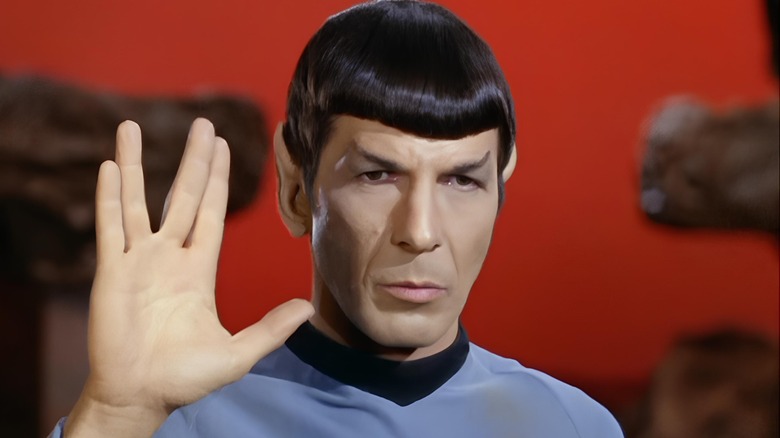
There is no more iconic hand gesture in pop culture than the split-fingered greeting used by Spock (Leonard Nimoy) and other Vulcans in "Star Trek." Usually accompanied by the phrase, "Live long, and prosper," the gesture requires splitting one's fingers between the middle and ring finger while extending the thumb, with the palm facing forward. But while many fans have seen it used throughout "Star Trek," many don't know its name, let alone its origins.
Spock's gesture is known as the Vulcan Salute. It was first seen in the episode "Amok Time," the episode of "Star Trek: The Original Series" in which Spock returns to Vulcan to compete in a mating ritual. Though not originally in the script for that episode, Nimoy felt it would be a good way to add more depth to Vulcan culture. "I suggested to the director that there should be some Vulcan thing that Vulcans do when they greet," Nimoy said in an Archive of American Television interview preserved by FoundationINTERVIEWS on YouTube. It was one of many aspects of Vulcan culture improvised by the actor . But the star clarified that the episode's writer, science fiction author Theodore Sturgeon, had come up with the phrase, "Live long, and prosper."
So, that's what the Vulcan Salute means within the universe of "Star Trek." But for Leonard Nimoy, it had a far more profound personal meaning rooted in his Jewish upbringing.

Leonard Nimoy's Vulcan Salute took inspiration from an ancient Jewish tradition
Leonard Nimoy, who played Spock on "Star Trek: The Original Series" and elsewhere, was raised in a Jewish household in Boston, Massachusetts, as the child of Ukrainian immigrants. His parents were observant, particularly his father, who brought his son along to High Holiday services at their local Orthodox synagogue. There, Nimoy witnessed a ritual that would go on to inform his Vulcan Salute.
Synagogue services on major holidays include the Priestly Blessing. Members of the priestly class of Kohanim — in the most simple terms, those with last names like Cohen and derivations thereof — bless the congregation by lifting their hands with the split-fingered gesture. The difference is that, in performing the Priestly Blessing, both hands are raised.
Crucially, members of the congregation are instructed to avert their gaze while the Blessing is recited, as the priests are said to be channeling the divine presence. Congregants often cover their faces with a tallis, a ritual shawl worn during prayer. But young Nimoy was much too curious to remain under the veil, so he would peer out at the Kohanim from under his father's tallis.
As noted on the Star Trek website, Nimoy wrote, "There were a group of five or six men facing the congregation and chanting in passionate shouts of a Hebrew benediction ... My dad said, 'Don't look.' ... I peeked. And when I saw the split-fingered gesture of these men ... I was entranced. I learned to do it because it seemed so magical. It was probably 25 years later that I introduced that gesture as a Vulcan greeting in 'Star Trek' and it has resonated with fans around the world ever since. It gives me great pleasure since it is, after all, a blessing."
The Significance And Meaning Of The Star Trek Hand Symbol
- Last updated Jul 26, 2023
- Difficulty Beginner
- Category Symbolism
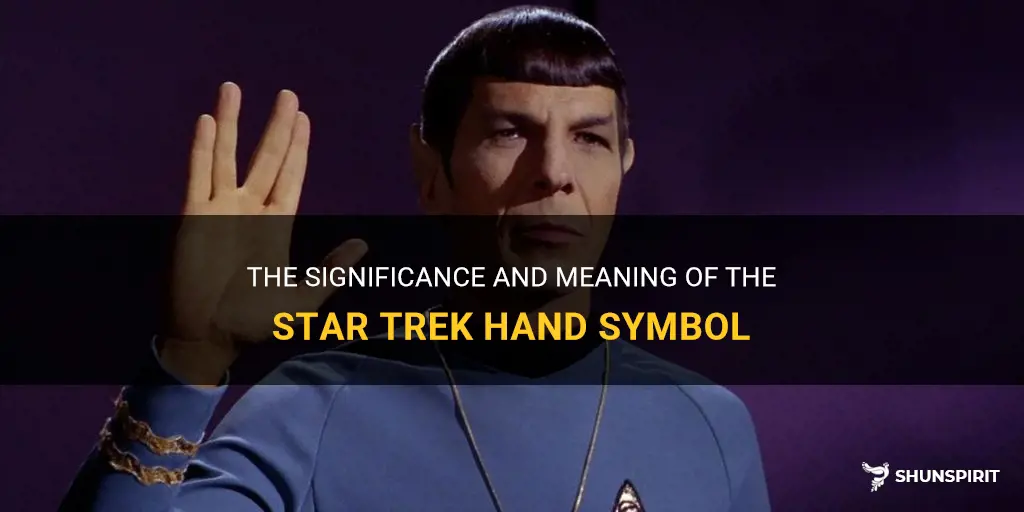
If there is one symbol that instantly transports us to the futuristic universe of Star Trek, it is the famous hand sign. With a simple gesture, the iconic hand symbol became synonymous with the famous greeting live long and prosper and came to represent the ideals of peace, logic, and unity in the Star Trek universe. But where did this symbol originate, and what does it truly mean? Join me on this journey to uncover the mysteries behind the Star Trek hand symbol, as we explore its historical significance and its profound impact on popular culture.
What You'll Learn
What is the origin of the star trek hand symbol, how did the star trek hand symbol become popularized, what does the star trek hand symbol represent in the show, are there any real-life meanings or origins to the star trek hand symbol, how has the star trek hand symbol been embraced by fans and pop culture outside of the show.

The hand symbol commonly seen in the science fiction franchise Star Trek has become widely known and recognized. The gesture, known as the Vulcan salute, is performed by raising the hand and separating the palm from the fingers, leaving only the middle and ring fingers together, while the index and little fingers remain extended. Also known as the "live long and prosper" sign, it has become an iconic symbol associated with the series.
The origin of the Vulcan salute can be traced back to the creator of Star Trek, Gene Roddenberry, and the actor who played the character of Spock, Leonard Nimoy. In the original Star Trek series, Nimoy's character, Spock, was half-human and half-Vulcan, a fictional alien race known for their logic and rationality. Nimoy wanted to incorporate a distinctive greeting for Vulcans that would reflect their unique culture and customs.
The inspiration for the Vulcan salute came from Leonard Nimoy's childhood experiences. He remembered attending a Jewish synagogue service where he observed a gesture performed by the rabbi when giving a blessing. The symbolic gesture involved the hands positioned similarly to the Vulcan salute, with the rabbi's thumb extended and touching his index finger. Nimoy found this ritualistic hand position fascinating and decided to adapt it for Spock's character as a way to emphasize the Vulcan culture's emphasis on logic and intellect.
When Nimoy approached Gene Roddenberry with the idea, the creator of Star Trek liked the concept and immediately incorporated it into the series. From that point forward, the Vulcan salute became an integral part of the Star Trek franchise, often associated with Spock's character and Vulcan culture as a whole.
The popularity of the Vulcan salute quickly spread beyond the boundaries of the show and became a recognizable symbol in popular culture. Fans of the series and non-fans alike started using the gesture as a greeting, a sign of solidarity, or simply as a way to express their love and appreciation for Star Trek.
The phrase "live long and prosper," often associated with the Vulcan salute, also originated from the Star Trek series. It was first used by Spock's character in the episode "Amok Time" and became one of his catchphrases. The phrase encapsulates the core values of the Vulcan civilization, which prioritizes knowledge, reason, and the pursuit of a long and prosperous life.
In conclusion, the Vulcan salute, or the iconic hand symbol from Star Trek, has its origins in Leonard Nimoy's childhood observations of a rabbi's gesture during a Jewish synagogue service. Nimoy adapted this hand position for his character, Spock, to symbolize the Vulcan culture's emphasis on logic and intellect. The Vulcan salute became a recognizable symbol in popular culture and is often associated with the phrase "live long and prosper," which epitomizes the values of the fictional Vulcan society.
What Does the UNK Symbol Mean and How is it Used?
You may want to see also
The Star Trek hand symbol, also known as the Vulcan salute, has become an iconic symbol in pop culture. It is often used as a greeting among Star Trek fans, and has even been adopted by famous personalities and celebrities. But how did this hand symbol become so popularized?
The Vulcan salute was first introduced in the original Star Trek television series, which aired from 1966 to 1969. The salute was developed by Leonard Nimoy, who played the character Spock, a Vulcan science officer on the Starship Enterprise. Nimoy wanted a distinctive greeting for his character, and took inspiration from a Jewish blessing he saw as a child.
The hand symbol itself is made by separating the middle and ring fingers, while the thumb is extended fully and the other fingers are closed. This creates a distinctive "V" shape with the hand. The gesture is accompanied by the phrase "Live long and prosper," which became synonymous with the salute.
When Leonard Nimoy first introduced the Vulcan salute on the show, it was not an instant hit. In fact, many people found it confusing and difficult to replicate. However, over time, the symbol gained popularity among Star Trek fans and became a recognized symbol of the franchise.
The popularity of the Vulcan salute reached new heights with the release of Star Trek movies and spin-off series. The gesture was often used by other characters in the Star Trek universe, further solidifying its association with the franchise.
Outside of the Star Trek fandom, the Vulcan salute gained wider recognition through various forms of media. It has been featured in popular television shows, movies, and even cartoons. The symbol has also been adopted by fans of the show as a way to identify themselves and show their love for Star Trek.
In addition, notable personalities and celebrities have also embraced the Vulcan salute, further contributing to its popularization. People like Barack Obama, Stephen Hawking, and Justin Trudeau have been spotted giving the salute at various events. This has helped to elevate the symbol's status and make it more widely known.
The Vulcan salute's popularity can also be attributed to its unique and distinct appearance. The "V" shape created by the hand symbol is visually striking and easily recognizable. Its association with the Star Trek franchise also adds to its appeal, as the show has a dedicated fan base that spans generations.
Overall, the Vulcan salute's journey from a simple greeting on a television show to a widely recognized symbol in popular culture is a testament to the enduring impact of Star Trek and its dedicated fan base. Its distinctive appearance, association with the franchise, and adoption by notable personalities have all contributed to its continued popularity. The Vulcan salute is now not only a symbol of Star Trek, but also a symbol of unity and connection among fans around the world.
Exploring the Meanings Behind CPT Symbols: Decoding the Secret Language of Medical Coding
In the iconic science fiction franchise Star Trek, one of the most recognizable symbols is the hand gesture often used by the characters. Known as the "Vulcan salute" or the "Live long and prosper" gesture, it has become synonymous with the show and has even entered popular culture.
The Vulcan salute is performed by raising the hand with the palm forward and the thumb extended, while separating the middle and ring fingers to form a "V" shape. The index and little fingers are bent, completing the distinct hand symbol. The gesture was first introduced by the character Mr. Spock, portrayed by Leonard Nimoy, in the original Star Trek series.
The meaning behind the Vulcan salute is rooted in the fictional alien race of Vulcans, who are known for their logic and emotional control. According to the show's mythology, Vulcans greet each other by raising their hand in this manner, accompanied by the phrase "Live long and prosper."
The gesture represents the Vulcan philosophy, which is centered around the pursuit of knowledge, logic, and the suppression of emotions. By using the hand symbol, Vulcans are reminding themselves and others of their commitment to these principles. It serves as a visual reminder of the value placed on reason and intellect, as well as a way to identify and connect with other Vulcans.
Outside of the Star Trek universe, the Vulcan salute has taken on a symbolic meaning of its own. Many fans of the show use the gesture as a sign of their appreciation for the franchise and its values. It has become a way to communicate a sense of unity and belonging within the Star Trek community. The phrase "Live long and prosper" has also been widely adopted as a mantra and a well-wishing expression.
The popularity of the Vulcan salute extends beyond Star Trek itself, with the symbol being recognized by people who may not even be familiar with the show. It has been referenced in other television series, movies, and even political campaigns. This demonstrates the lasting impact of the Star Trek franchise and its ability to create iconic symbols that resonate with audiences.
In conclusion, the Vulcan salute is a hand gesture used by the fictional Vulcan race in the Star Trek series. It symbolizes their commitment to logic and emotional control, as well as a means of identification. The gesture has become a cultural phenomenon, representing unity and appreciation for the franchise. Whether you're a Star Trek fan or not, the Vulcan salute serves as a visual reminder of the show's enduring legacy. So, next time you see the hand symbol, remember to "live long and prosper."
Decoding the Hidden Messages: Understanding Dodge Dashboard Symbols and Their Meanings
The Star Trek hand symbol, commonly known as the Vulcan salute, has become iconic in popular culture. It is recognized worldwide as a symbol of greeting and unity among Star Trek fans. However, it is interesting to explore if there are any real-life meanings or origins behind this gesture.
The Vulcan salute consists of lifting the hand flat and parting the fingers between the middle and ring finger, while the thumb is held against the palm. The gesture was first introduced in the original Star Trek series by Spock, a Vulcan character portrayed by Leonard Nimoy. In the show, it was described as a traditional Vulcan greeting, accompanied by the phrase "Live long and prosper."
The origins of the Vulcan salute, however, can be traced back to Leonard Nimoy's childhood. In his autobiography, "I Am Spock," Nimoy explains that the hand symbol was inspired by a Jewish blessing he witnessed in his synagogue as a child. The blessing, known as the "priestly blessing" or "raising of the hands," is performed by Kohanim (descendants of the Jewish priestly caste) during certain religious ceremonies.
In the blessing, the Kohanim raise their hands with the fingers spread apart, similar to the Vulcan salute. Nimoy was deeply moved by this ritual and its symbolism of unity and connection. He later incorporated it into his portrayal of Spock to add depth and history to the Vulcan culture.
The Vulcan salute quickly became associated with Spock and the Star Trek franchise, and it soon gained popularity beyond the show's fan base. Star Trek conventions, interviews, and public appearances by Leonard Nimoy often included the iconic hand gesture. Over time, the salute came to represent the ideals of peace, logic, and understanding espoused by the Vulcans in the Star Trek universe.
The cultural impact of the Vulcan salute is further exemplified by its adoption and recognition in diverse communities worldwide. The symbol is used as a sign of solidarity among Star Trek fans, often accompanied by the phrase "Live long and prosper." It has also been embraced by various organizations and individuals to promote goodwill and inclusivity.
In conclusion, while the Vulcan salute originated in the fictional universe of Star Trek, its real-life meaning and origins can be traced back to Leonard Nimoy's personal experiences and cultural influences. The hand symbol's connection to the Jewish blessing and its embodiment of unity and connection have contributed to its lasting popularity and significance in popular culture. The Vulcan salute serves as a reminder to embrace diversity, seek understanding, and strive for peace in the real world.
Exploring the Meaning and Importance of Field Weld Symbols
The Star Trek hand symbol, also known as the Vulcan salute, has become an iconic part of popular culture. This hand gesture, made by extending the palm forward with the fingers split between the middle and ring fingers, was first introduced in the original Star Trek series by the character Mr. Spock, played by Leonard Nimoy.
Despite its origins in a science fiction television show, the Vulcan salute has been embraced by fans and has become a symbol of unity and peace. The gesture is often used by fans to identify themselves as part of the Star Trek community, and it has been adopted by various organizations and individuals outside of the show.
One of the most notable instances of the Vulcan salute being embraced by popular culture was during the inauguration of President Barack Obama in 2009. Leonard Nimoy, who created the hand sign, was present at the event and performed the Vulcan salute when he was introduced to the crowd. This moment not only highlighted the cultural significance of Star Trek but also showed how the hand symbol has transcended its fictional origins to become a symbol of hope and unity.
The Vulcan salute has also been used in various forms of media and entertainment. It has made appearances in other television shows and movies, such as The Big Bang Theory, where the character Sheldon Cooper often uses the salute as a reference to his love for Star Trek. Additionally, the hand symbol has been featured in advertisements, artwork, and fan creations, showcasing its widespread popularity.
Outside of media and entertainment, the Vulcan salute has been embraced by various organizations and individuals as a symbol of peace and unity. It has been used in protests and demonstrations as a way to express solidarity and promote inclusivity. It has also been incorporated into various logos and designs, representing values such as diversity and acceptance.
The influence of the Vulcan salute can even be seen in scientific and technological advancements. For example, NASA astronauts Mark Lee and Jan Davis famously performed the Vulcan salute in space during the STS-47 mission in 1992. This gesture not only showcased their love for Star Trek but also highlighted the connection between science fiction and scientific exploration.
In conclusion, the Star Trek hand symbol, or Vulcan salute, has been embraced by fans and popular culture outside of the show. It has become a symbol of unity, peace, and hope, and has been adopted by various organizations and individuals. Through its appearances in media, entertainment, and even space exploration, the Vulcan salute continues to exemplify the influential impact of Star Trek on society.
Deciphering the Meaning Behind Satanic Symbols: Unveiling the Veil of Darkness
Frequently asked questions.
The Star Trek hand symbol is known as the Vulcan salute, which is a hand gesture used by the fictional Vulcans in the Star Trek universe. It consists of raising the hand, separating the fingers between the middle and ring finger, and keeping the thumb extended. The gesture is often accompanied by the phrase "live long and prosper."
The Star Trek hand symbol is not a real sign language gesture, but it was inspired by a Jewish blessing. Leonard Nimoy, the actor who played Mr. Spock, based the Vulcan salute on the traditional priestly blessing performed by Jewish Kohanim during religious ceremonies. Nimoy wanted to create a unique gesture for his character that conveyed a sense of peace and spirituality.
The Star Trek hand symbol gained popularity through the Star Trek television series and subsequent movies. As the character of Mr. Spock became increasingly popular, so did his iconic gesture. Fans of the show began adopting the Vulcan salute as a way to express their love for the series and to identify themselves as Star Trek enthusiasts. The hand symbol has since become a widely recognized symbol of Star Trek fandom.

- Seti Author Editor Reviewer

- Aarti Deegwal Author Editor Reviewer
It is awesome. Thank you for your feedback!
We are sorry. Plesae let us know what went wrong?
We will update our content. Thank you for your feedback!
Leave a comment
Symbolism photos, related posts.

The Hidden Meanings Behind the Arrowhead Symbol
- Jul 19, 2023
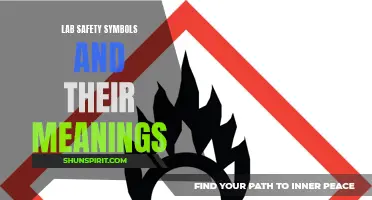
Understanding Lab Safety Symbols and Their Meanings: A Comprehensive Guide
- Jul 25, 2023
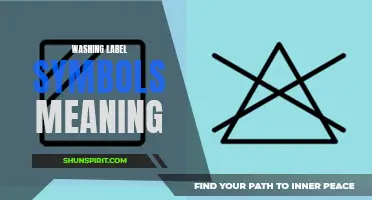
Decoding the Mystery: Understanding the Meaning Behind Washing Label Symbols
- Jul 26, 2023
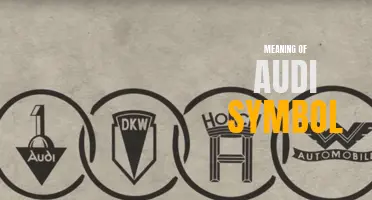
Decoding the Symbol: Unveiling the Hidden Meaning Behind the Audi Logo
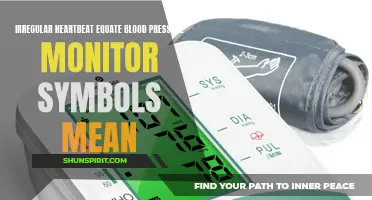
Decoding the Symbols: What Do the Irregular Heartbeat Equate Blood Pressure Monitor Symbols Mean?
- Jul 20, 2023
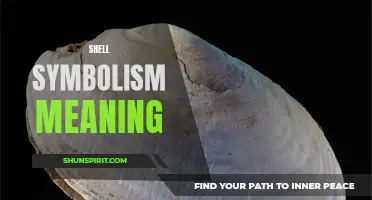
The Symbolic Meaning of Shells: Exploring Their Spiritual Significance
- Jul 21, 2023

Star Trek's Famous Vulcan Salute Has A Deeper Meaning That Truly Pleased Leonard Nimoy
I f one visits the legendary Grauman's Chinese Theater in Hollywood, California (now called the TCL Chinese), one can see the handprints of the cast and creator of "Star Trek." On the event of the franchise's 25th anniversary in 1991, Walter Koenig, Nichelle Nichols, William Shatner, George Takei, James Doohan, and DeForest Kelley all put their handprints on the cement next to their respective signatures. According to a story Takei told at a "Star Trek" convention (that this author personally attended), the cast were instructed to sign their names but not to put their hands in the cement. Takei, hating the restriction, plopped in his handprint anyway, and his fellow cast members immediately followed suit.
Leonard Nimoy, as visiting Trekkies will see, slapped his hand into the cement with his middle and ring fingers parted and his thumb out, arranged in the traditional Vulcan salute seen so often throughout "Star Trek."
That salute first appeared in the "Star Trek" episode "Amok Time" (September 15, 1967) and was accompanied by a notable Vulcan slogan, "Live long and prosper," initially penned by teleplay writer Theodore Sturgeon. In a 1968 interview with the New York Times , Nimoy noted that he was allowed to invent a lot of the idiosyncrasies of the Vulcan species, saying that they would be hand- and gesture-oriented. Nimoy couldn't have predicted how immensely popular "Star Trek" would become, nor that so many other actors would play Vulcans -- and adopt his salute -- in the years that followed.
An insightful 2015 article in the Washington Post quoted Nimoy as having invented the salute as an expression of his Jewish heritage. The hand shape, he said, was meant to evoke a particular letter of the Hebrew alphabet.
Read more: The Main Star Trek Captains Ranked Worst To Best
The Divine Hug
One can see the Vulcan salute in all manner of Judaica. The website Chabad.org explains the gesture of Priestly Blessing in detail:
"The Hebrew term for the Priestly Blessing, administered by the descendants of Aaron, is Birkat Kohanim , also known as Nesi'at Kapayim , the 'lifting of the hands,' because of the priests' uplifted hands, through which the divine blessings flow. Performed in the synagogue, the Priestly Blessing is one of the most spiritually uplifting moments in Jewish life, as the entire congregation is embraced in a 'divine hug.'"
Two open hands pushed away from the body form a diamond shape, allowing the Divine through.
In a 2013 interview, Nimoy said that his fingers, when in the Vulcan salute, resemble the letter shin, the first letter in Shalom, in Shaddai (one of the many names of God), and also in Shekhinah , part of a kabbalistic veneration of divine feminine energies, but a word that had several meanings overall. Nimoy recalled reciting Shekhinah prayers as a child, and it was from those days in temple that he was inspired to form the Vulcan hand salute. The Post cited a StarTrek.com interview wherein Nimoy recalled its function, saying, "The light from this Deity could be very damaging. So we are told to protect ourselves by closing our eyes." He continued:
"They get their tallits over their heads, and they start this chanting. And my father said to me, 'Don't look'. At first he obliged, but what he could hear intrigued him. I thought, 'Something major is happening here.' So I peeked. And I saw them with their hands stuck out from beneath the tallit like this."
There it was.
Trek Yourself Before You Wreck Yourself
Nimoy recalled wanting to invent something notable for the scene in "Amok Time" when Spock was on screen with other Vulcans for the first time. He didn't necessarily brainstorm the above prayers but clearly took inspiration from them. It was a simple gesture he invented on set. Surprisingly, it stuck. It helped that Trekkies watching at home could recreate it in an instant. Nimoy added:
"Boy, that just took off. It just touched a magic chord. [...] [M]ost people to this day still don't know [the history] [...] People don't realize they're blessing each other with this!"
When you flash a "Live long and prosper" salute, you are actually evoking divine energies. Trekkies may be passing winking pop culture references to one another on the floor of "Star Trek" conventions, but they are also giving each other holy blessings. There's something beautiful about that. When President Obama -- a self-professed Trekkie -- met Nichelle Nichols in 2012, they posed for a picture wherein both flashed the salute. Talk about cultural penetration. As far as I have been able to determine, Obama is the only president to have given a Vulcan salute.
Of course, the salute has become so common in "Star Trek" that it can be thrown around without any sense of nobility or wonderment. In an episode of "Star Trek: Lower Decks," Ensign Becket Mariner (Tawny Newsome) waggles Vulcan salutes sarcastically around in front of her mother, being generally caustic and dismissive. Any "sacred" qualities attached to the gesture have apparently been prodded and mocked by the young hotshot.
Read the original article on /Film .
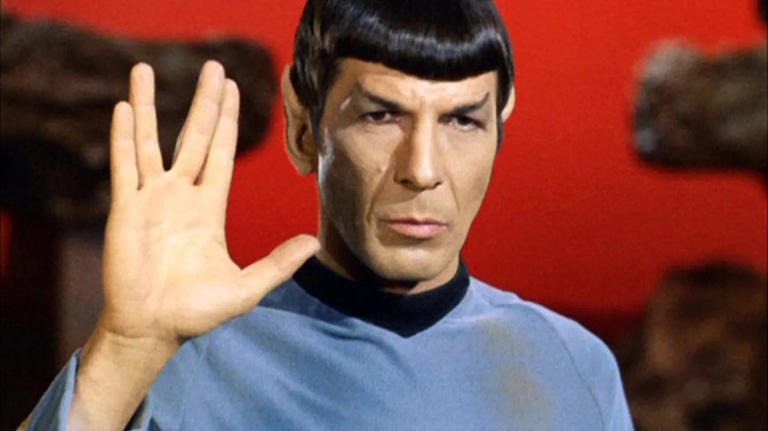
- The Inventory
Support Quartz
Fund next-gen business journalism with $10 a month
Free Newsletters
The history behind Leonard Nimoy’s Vulcan salute
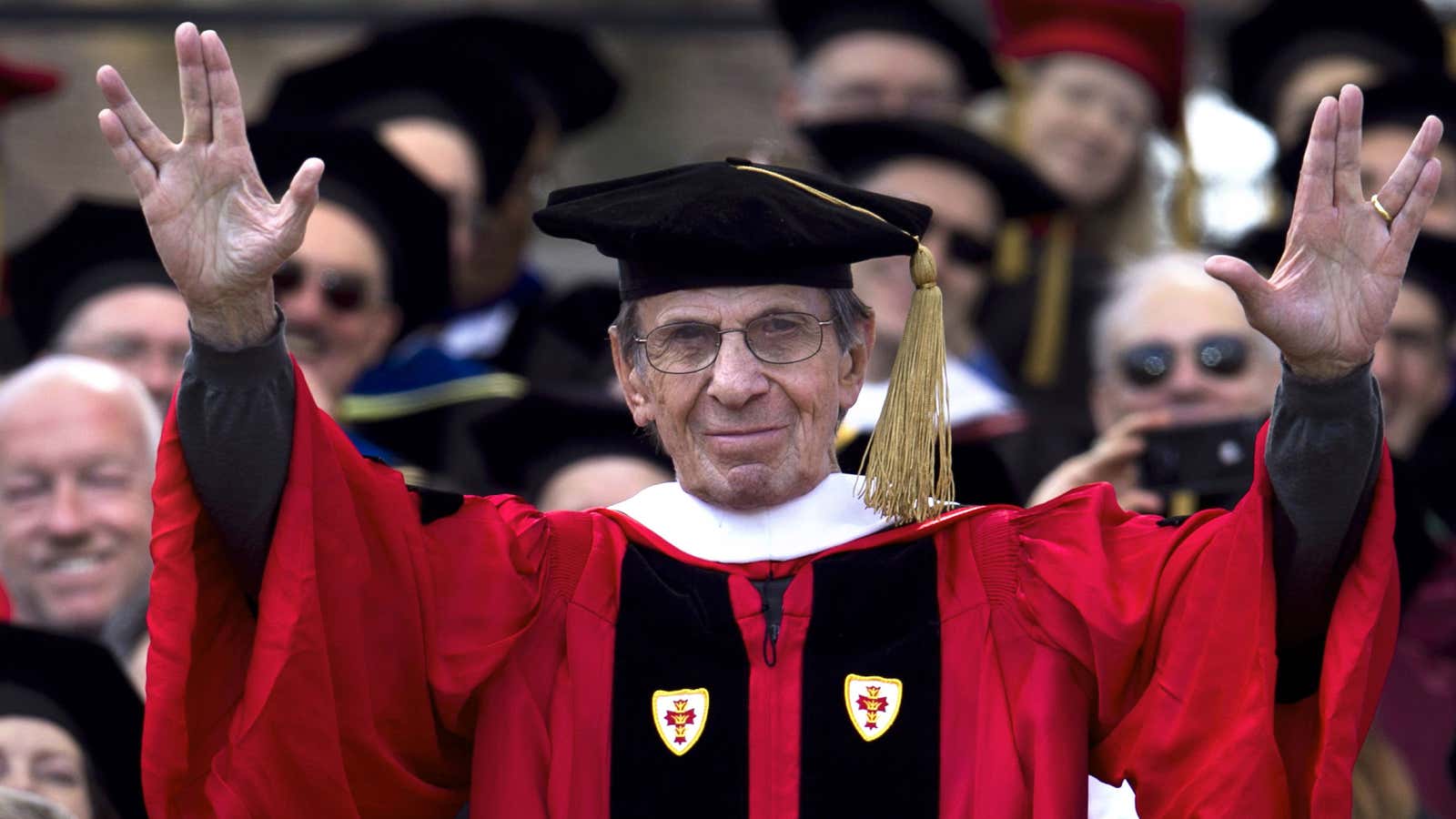
Leonard Nimoy’s passing at the age of 83 is prompting a flood of reminiscences about the actor, artist, and poet best known for his portrayal of the half-human/half-Vulcan Spock on the television series and movies Star Trek .
Many will remember him performing his trademark four-finger Vulcan salute, which the actor actually created himself:
Nimoy drew on his orthodox Jewish upbringing to invent the iconic hand gesture, and he wrote about the process of finding it in his memoir, I am Spock :
For what would soon become known as the Vulcan salute, I borrowed a hand symbol from Orthodox Judaism. During the High Holiday services, the Kohanim (who are the priests) bless those in attendance. As they do, they extend the palms of both hands over the congregation, with thumbs outstretched and the middle and ring fingers parted so that each hand forms two vees. This gesture symbolizes the Hebrew letter shin, the first letter in the word Shaddai, `Lord.’ … So it was that, when I searched my imagination for an appropriate gesture to represent the peace-loving Vulcans, the Kohanim’s symbol of blessing came to mind.
In a chat with the Baltimore Sun in 2000, Nimoy explained how he got the idea:
In the blessing, the Kohanim (a high priest of a Hebrew tribe) makes the gesture with both hands, and it struck me as a very magical and mystical moment. I taught myself how to do it without even knowing what it meant, and later I inserted it into “Star Trek.” There was a scene in one episode that needed something. People were seeing other members of the Vulcan race for the first time, and I thought it called for a special gesture.
📬 Sign up for the Daily Brief
Our free, fast, and fun briefing on the global economy, delivered every weekday morning.
Emoji dictionary
🖖 vulcan salute emoji.
[ vuhl -k uh n s uh - loot ih- moh -jee ]
What does 🖖 Vulcan Salute emoji mean?
Live long and prosper, friends! If you ever need to spread the love to your geekier friends, then flash a 🖖.
The Vulcan salute emoji, 🖖, is perfect for showing your Star Trek cred or sci-fi pride more generally.
Related words
Where does 🖖 vulcan salute emoji come from.
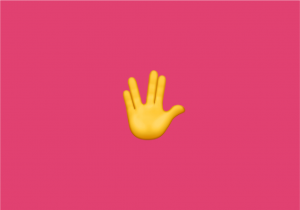
The Vulcan Salute emoji is officially called the raised hand with part between middle and ring fingers emoji. And, that’s exactly what the emoji shows across platforms. Its default hue is yellow, but skin-tone modifiers allow users to change color. It joined emoji keyboards under Unicode 7.0 in 2014.
The emoji commonly goes by the Vulcan salute because the gesture was popularized by Mr. Spock (Leonard Nimoy), who used it as a greeting in the sci-fi franchise, Star Trek . Nimoy first used the gesture in the 1967 TV episode “Amok Time,” in which Spock comes into contact with other members of his Vulcan race.
Nimoy wanted the Vulcans to have a way of greeting one another similar to human hand gestures. In an interview with New York Times , Nimoy said that his Vulcan salute was inspired by a gesture that he witnessed during a Jewish religious service when he was a boy. Jewish priests perform the actual religious gesture with both hands to form the Hebrew letter shin , ש.
The greeting Live long and prosper! has also accompanied the Vulcan salute ever since its debut in “Amok Time,” also inspired by Jewish scripture, with Deuteronomy 5:33 being the most cited inspiration for the phrase.
The Vulcan salute went memetic almost immediately after Nimoy’s first usage of the gesture. According to Nimoy, mere weeks after “Amok Time” aired, people were already using the gesture to greet him everywhere he went. The gesture was first popular among Star Trek fans but the gesture’s similarity to the popular V-shaped peace hand gesture (✌️), both in finger placement and good-willed intent, helped it catch on outside that community.
The Vulcan salute was popular long before the rise of social media, so it comes as no surprise that the emoji version took off right away after Unicode added it on June 16, 2014.
🖖 — Kim Ahlström (@Kimtaro) June 16, 2014
Prior to that day, users had to make due with typographical substitutes.
@pruet \V/_ Vulcan salute — Keng ☂ (@kengggg) November 14, 2007
Examples of 🖖 Vulcan Salute emoji
Who uses 🖖 vulcan salute emoji.
The Vulcan salute emoji is used anytime someone wants to flash the greeting and good wishes. It can be Star Trek fans …
Happy Birthday to our Trekkie Girl Carole! Have a trektastic day! 🖖 🍸🍾 — Trekkie Girls (@TrekkieGirls) October 17, 2016
Live long & prosper. Trekkie and proud 🖖 pic.twitter.com/omklaAa5ak — Lola Dreambomb (@Lola_Dreambomb) July 22, 2016
… or your non-Trekkie but self- avowed nerd friends. In this vein, the emoji can suggest anything “geeky” or “far out.”
Happy birthday nerd. May you live long and prosper 🖖 in Jesus name. God bless you homie @J_Anowa — Bruce Wayne💰💵 (@Bizzle025) July 16, 2018
embrace the martian 🖖 — Genius (@Genius) July 17, 2018
The Vulcan salute emoji is also commonly used when tweeting about (or to) actors that appeared in Star Trek.
Happy 78th Birthday to Patrick Stewart …🖖 pic.twitter.com/bgA4gsL0Bg — Phil Murphy (@crashtesterX) July 13, 2018
George Takei knows the score. 🖖 https://t.co/qInzV1IRsH — Ross Colquhoun (@rosscolquhoun) June 24, 2016
William Shatner is in Lowell today 🖖 — V. Arun (@A_Venugopal_97) June 11, 2015
While the Vulcan salute emoji is widely used when discussing anything Star Trek related, such as old episodes or new films, it can also mark content dealing with science fiction works in general.
🤔 Like anyone could possibly just rank their favorite all-time episode @StarTrek ?!? Ridiculous! #TrekRanks 🖖📊 https://t.co/KYzfPRXacD — TrekRanks Podcast 🖖📊 (@TrekRanks) July 24, 2018
For all who love Sci-Fi movies that really fuck with your head and concept of reality/time, watch 'Arrival' .. great movie, still confused as tits 10/10 wont sleep tn 👍🖖 — MariJane (@mariman777) July 25, 2018
This is not meant to be a formal definition of 🖖 Vulcan Salute emoji like most terms we define on Dictionary.com, but is rather an informal word summary that hopefully touches upon the key aspects of the meaning and usage of 🖖 Vulcan Salute emoji that will help our users expand their word mastery.
- By clicking "Sign Up", you are accepting Dictionary.com Terms & Conditions and Privacy policies.
- Email This field is for validation purposes and should be left unchanged.
Other categories
- Famous People
- Fictional Characters
- Gender & Sexuality
- Historical & Current Events
- Pop Culture
- Tech & Science
- Translations

How Leonard Nimoy's Roots Inspired The Vulcan Salute
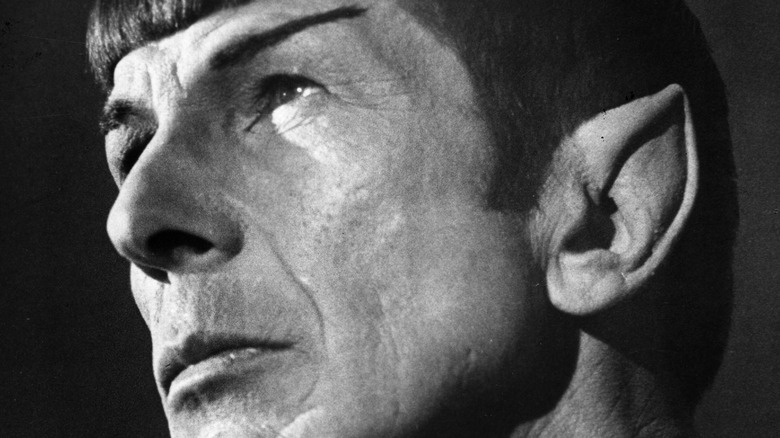
The Vulcan salute is instantly recognizable to most people, even if they're not "Star Trek" fans, consisting of an open palm with the pinky and ring fingers pressed together on one side of the "V," with the middle and pointer making up the other side, the thumb extended on its own. According to a 2012 entry from the official Star Trek blog , the gesture was first performed by the character of Mr. Spock, played by actor Leonard Nimoy, on the episode "Amok Time," which premiered on television in 1967. The episode takes place on the planet Vulcan, where Spock uses the gesture to greet fellow Vulcan T'Pau, played by Celia Lovesky, probably little knowing the importance the gesture would have to "Star Trek" lore and pop culture history in general.
Nimoy explained in 2012 that he had come up with his character's gesture himself: "The idea came when I saw the way Joe [director Joseph Pevney] was staging the scene. He had me approach T'Pau and I felt a greeting gesture was called for. So I suggested it to Joe, who accepted it immediately. Gene [Roddenberry, the creator of "Star Trek"] was not involved." Nimoy noted in his 1995 autobiography "I Am Spock," quoted by the website Quartz in 2015 on the occasion of Nimoy's death at the age of 83, that he had adapted the symbol from Orthodox Judaism, specifically a hand symbol the Konahim, or priests, make as they bless the congregation during High Holiday services "with thumbs outstretched and the middle and ring fingers parted so that each hand forms two vees."
The Vulcan salute copies an Orthodox Jewish gesture with special meaning
Nimoy wrote for the Star Trek blog that he had grown up in Boston's West End neighborhood, which was home to a large number of immigrants. He attended a local Orthodox Jewish synagogue with his family. They were particularly observant of the Jewish High Holidays. His father once instructed young Nimoy not to look at the priests as they prepared to say the benediction that included the gesture, as "it is believed that during this prayer, the 'Shekhina,' the feminine aspect of God comes into the temple to bless the congregation" and the accompanying light could be damaging. Some people traditionally close their eyes to protect them. Nimoy secretly peeked and recalled that upon seeing "the split-fingered gesture of these men ... I was entranced. I learned to do it simply because it seemed so magical." Around 25 years later he introduced a version of the hand sign as the Vulcan salute, accompanied with its own blessing: "Live long and prosper."
Writer Lindsay Traves explored the history of the Vulcan salute for the Star Trek blog in 2019 in honor of Jewish History Month. Rabbi Howard Morrison of Toronto's Beth Emeth Synagogue explained that the gesture, made with both hands with thumbs connected, forms the Hebrew letter Shin, which is the first letter of Shaddai, one of the names for God in the Torah. The gesture didn't come easily to all "Star Trek" actors; per the IMDb , Celia Lovsky had to have her fingers taped together in order for T'Pau to return Spock's greeting.
- Forgiveness
- Resurrection
The Jewish Origin of the Vulcan Salute
By Rabbi Yonassan Gershom - May 24, 2009
The Vulcan "live long and prosper" salute is based upon a blessing gesture used by the Jewish priests (kohanim) during the worship service, and was created by Leonard Nimoy (Spock), who drew on his on childhood synagogue experiences for the inspiration.
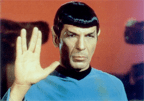
Nimoy felt that there should be some kind of distinctive greeting among Vulcans, analogous to a handshake or a bow. Alan Dean Foster's novelization, based on an early script, has Spock kneeling before the Vulcan matriarch, T'Pau, who places her hands on his shoulders, like royalty dubbing a knight. But Nimoy didn't care for this. Previous episodes had already established that Vulcans are touch telepaths. Therefore, a touch on the shoulders would be an invasion of privacy. Instead, Nimoy drew upon his own Jewish background to suggest the now-familiar salute. Back in the 1960s, hippies who watched "Amok Time" thought the salute was a variation of the two-fingered peace sign. But we Jews knew better. The Vulcan salute came not from protest marches, but from the pulpit of Nimoy's childhood synagogue.
The Vulcan greeting is based upon a blessing gesture used by the kohanim (koe-hah-NEEM) during the worship service. The kohanim are the genealogical descendants of the Jewish priests who served in the Jerusalem Temple. Modern Jews no longer have priests leading services as in ancient times, nor do we have animal sacrifices anymore. (Yes, people really do ask about that!) The sacrificial system ended with the destruction of the Temple by the Romans in the year 70 C.E. However, a remnant of the Temple service lives on in the "kohane blessing" ritual (duchenen in Yiddish) that is performed on certain holy days.
The actual blessing is done with both arms held horizontally in front, at shoulder level, with hands touching, to form the Hebrew letter "shin." This stands for the Hebrew word for "Shaddai," meaning "Almighty [God]." Nimoy modified this gesture into one hand held upright, making it more like a salute. So, technically, the Vulcan greeting is not the same thing as the ceremonial Jewish blessing. Still, the resemblance is close enough to evoke instant recognition among knowledgeable Jews.
During the synagogue service, the worshippers are not supposed to look at the kohanim while the blessing is being given. The reason for this is to focus our attention on the words of the prayer itself, rather than on the personalities of the kohanim. The kohanim are merely the channels, not the source, of the blessing, which comes from God. Unfortunately, all sorts of silly superstitions have arisen about this ritual, such as "Don't look at the kohanim, or you'll go blind!" and other nonsense. The real reason is simply to focus on receiving blessings directly from God, not from human beings.
Like most Jewish children, young Leonard Nimoy could not contain his curiosity about what the kohanim were really doing up there in front of the congregation. He writes:
"The special moment when the Kohanim blessed the assembly moved me deeply, for it possessed a great sense of magic and theatricality... I had heard that this indwelling Spirit of God was too powerful, too beautiful, too awesome for any mortal to look upon and survive, and so I obediently covered my face with my hands. But of course, I had to peek." (From his autobiography, I Am Spock.)
Nimoy survived his peeking unscathed, and saw the kohanim extending their fingers in the mystical "shin" gesture. That magical moment remained with him for life, and was there to draw upon years later when he invented the Vulcan salute.
Did Gene Roddenberry know, at the time of filming, that the Vulcan salute was based on a Jewish ritual? That question remains unanswered. My sense is that he probably didn't or he would have objected to it on the grounds of its being too "Judeo-Christian." More likely, he thought it was a weird variation of the peace sign. Certainly, that's how gentile Trekkers saw it for many years. Only much later did Nimoy publicly explain the source of his inspiration.
We should also note that the prohibition against peeking only applies during the actual blessing ritual. The gesture itself is nothing secret. You can see it openly displayed in books and on amulets, jewelry, wall decorations, and gravestones. Contrary to urban legend, Nimoy was not violating any Jewish taboos by using this gesture on "Star Trek," especially since he modified it from the original version. I, for one, think it's absolutely wonderful that something so authentically Jewish has become universally recognized as a greeting of peace. More than anything else in Trekdom, the Vulcan salute says to me, "Here there be Jews." It also provides a diplomatic way for me to greet female Trekkers at conventions without shaking hands. (Orthodox Jews do not shake hands with the opposite sex. I suppose that would also hold true for intersexed alien species.)
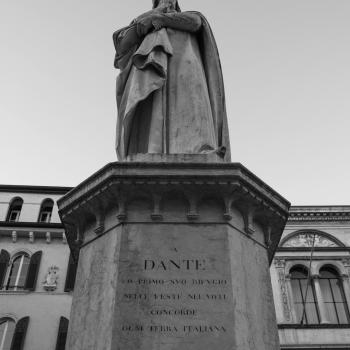
- Library of World Religions
- Advertise With Us
- Write for Us
- Privacy Policy
- Terms of Service
- Do Not Sell My Data
- Radiant Digital
- Manage Newsletter Subscriptions
- Unsubscribe From Notifications

Vulcan finger-touching
- View history
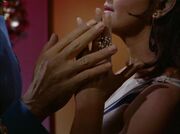
Vulcan finger-touching between Spock and a Romulan commander
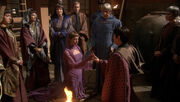
Finger-touching at a Vulcan marriage ceremony

Saavik assisting the regenerated Spock to endure pon farr
Vulcan finger-touching was a ritualistic gesture among Vulcans involving the index and middle fingers. It was used throughout their culture, including in public as a greeting or to signify affection, intimacy, respect, or meditation. It was also used at reunions, at wedding ceremonies, and during the pon farr . Contact ranged from a simple two-fingertip touch to tracing around another's hand.
If a Vulcan was bonded with a member of another species, the non-Vulcan would adopt the practice. The Romulans also had knowledge of the ritual, and it could be used as a greeting or a sign of interest. It could also be used as part of a meditative practice to center and control one's emotions or to purge them. ( TOS : " Journey to Babel ", " The Enterprise Incident "; Star Trek: The Motion Picture ; Star Trek III: The Search for Spock ; ENT : " Home ")
Notable occurrences [ ]
The instances in which Vulcan finger-touching was used included the following examples:
T'Pol and Koss during their wedding on Vulcan in 2154 . ( ENT : " Home ")
T'Pol and Koss upon greeting each other later that year. ( ENT : " The Forge ")
Sarek of Vulcan and Amanda Grayson of Earth on a diplomatic mission aboard the USS Enterprise in 2268 . ( TOS : " Journey to Babel ")
Spock and a female Romulan commander on her flagship later in 2268. ( TOS : " The Enterprise Incident ")

Spock performing finger touching during meditation on Vulcan, 2270s
During Vulcan meditation, Spock used finger touching as part of his meditation practice to expunge his emotions through Kolinahr . ( Star Trek: The Motion Picture )
A young, revived Spock, who was entering pon farr , with Saavik on the Genesis Planet in 2285 . Spock used the gestures she taught him while attempting to center his mind and emotions. ( Star Trek III: The Search for Spock )
Hallucination [ ]
While trapped in the Delta Quadrant in 2375 , a telepathic pitcher plant made the crew of USS Voyager believe they had returned to the Alpha Quadrant . Tuvok imagined that he was reunited with his wife T'Pel and greeted her in this manner. ( VOY : " Bliss ")
Background information [ ]
Regarding the origins of the Vulcan gesture involving touching of two fingers with two fingers, Leonard Nimoy explained in his book I Am Spock that the gesture was not meant to be the Vulcan equivalent of a Human kiss , but rather the Vulcan equivalent of holding hands in public: " The question came up as to what public sign of affection, if any, Sarek and his Human wife would display. Handholding was clearly out, but perhaps finger-to-finger contact of a ceremonial, dignified nature might work. Mark [Lenard] and Jane [Wyatt] took my comments to heart, and came up with the wonderful gesture where Amanda rests her first two fingers lightly upon Sarek’s two fingers. It worked beautifully, and added to the texture of [the episode]. " Nimoy also described Vulcan finger-touching as "the beginning of the Vulcan mating ritual", "the Vulcan two-fingers-touching 'embrace'", and "the Vulcan version of foreplay". ( I Am Spock , hardback ed., pp. 71-72, 237)
According to Harve Bennett , Leonard Nimoy imagined that, as a seven-year-old, Spock had engaged in some Vulcan finger-touching upon first meeting his betrothed, T'Pring . Nimoy related this concept to Bennett while they were writing Star Trek III: The Search for Spock . ( Star Trek: The Magazine Volume 3, Issue 8 , p. 31)
While filming the Vulcan finger-touching with Saavik actress Robin Curtis for Star Trek III: The Search for Spock , Stephen Manley , portraying the seventeen-year-old Spock, grabbed Curtis' hands with both of his hands, an improvised gesture intended to portray passion. Leonard Nimoy, as the film's director, strongly approved of this moment, even fighting for it to remain in the movie when the executives at Paramount were eager to edit it out because it was eliciting a lot of laughs from viewers who weren't entirely familiar with Star Trek . Manley was extremely grateful for Nimoy insisting on the scene remaining. At photo opportunities during Star Trek conventions from 2005 onward, Manley would typically hold his fingers touching those of female fans who wanted a picture taken with him. ("Spock: The Early Years", Star Trek: Motion Picture Trilogy (DVD) / (Blu-ray) special features)
A scene in the script of unmade movie Star Trek: The First Adventure involved Spock, as a cadet, teaching a stripper how to do Vulcan finger-touching. The script's stage directions identified this gesture as actually being pon farr .
In the first draft script of ENT : " Fusion " (which had the working title "Equilibrium"), Vulcans T'Pol and Szon did some finger-touching during a dream T'Pol experienced. This finger-touching was to have taken place in Enterprise 's mess hall , empty apart from the pair, and was described in the teleplay's stage directions thus: " Szon moves to her, reaching out two fingers in a traditional Vulcan gesture. T'Pol presents the back of her hand to him, and Szon presses his fingers against her flesh… T'Pol reacts to the sensual touch. " In the dream sequence, the finger-touching preceded a very sensual mind meld between the couple.
The writers of the film Star Trek debated, among themselves, about the possibility of having Spock and Uhura finger-touching in a turbolift scene from that movie. Ultimately, J.J. Abrams pointed out that such behavior would be unfamiliar and consequently puzzling to a new audience, so the pair of characters instead kiss in the same scene. In a Q&A, Roberto Orci and Alex Kurtzman agreed with this conclusion. [1]
- 3 Ancient humanoid

Give Me a Sign: The Stories Behind 5 Hand Gestures
By rob lammle | jan 19, 2023, 10:28 am est.

So much can be said with a hand gesture. Here are the stories behind gestures you might use every day, and some you might not.
Table Of Contents
1. the vulcan salute, 2. the shaka sign, 3. the corna, 4. the pledge of allegiance, 5. the high five.
We all know it, even if we can't all do it. The Vulcan Salute, made famous by Leonard Nimoy as Mr. Spock on the original Star Trek , has become a cultural icon recognized even by those who have never been to a sci-fi convention. And while the gesture is meant to be from another planet, its inspiration is anything but alien.
When Nimoy was a child, he witnessed a Jewish ritual called the "kohane blessing," which uses a hand sign meant to resemble the Hebrew letter "shin," which symbolizes the Hebrew word for "Shaddai," meaning "Almighty (God)." (Got that?) It's made by splitting the hand down the middle—holding the index and middle fingers together, the ring and pinky fingers together—and then the thumb pressed firmly against the side of the hand. The Orthodox priest giving the blessing holds both hands out in front of him in these strange configurations, palms down. When Nimoy was developing a greeting to be used between Vulcans, he remembered the sign and adapted it, using only one hand held up, and pulling his thumb away from the rest of the hand.
Nimoy had no problem doing the salute, but not all Trek actors have been so lucky.
William Shatner had to have his fingers tied together with fishing line whenever Captain Kirk needed to use the sign. Even the latest pointy-eared Vulcan, actor Zachary Quinto, who played a younger Mr. Spock in the recent blockbuster film, had to have his fingers stuck together with the skin-safe superglue used by hospitals as a replacement for traditional stitches.
The oldest origin story goes back to the days when Spanish sailors first landed on the Hawaiian Islands. Unable to speak the native tongue, but trying to be friendly, the Spaniards offered to share a drink by mimicking a bottle with their hand with the gesture and tilting back their head. This became such a common greeting that the natives simply believed that's how the Spanish said hello, so they started using the sign whenever the two groups encountered one another.
Another theory, from the mid-20th Century, claims the sign was inspired by the wave of a beloved local named Hamana Kalili, who'd lost the middle fingers on one hand. There are multiple theories as to how he lost his fingers: there was a shark attack, they were blown off while using dynamite to catch fish, or perhaps the digits were lost in an accident while working on a sugar plantation. But no one knows for sure anymore.
As if the origin of the gesture isn't mysterious enough, the word Shaka isn't even Hawaiian. However, most people agree the name goes back to a local used car salesman, Lippy Espinda, who would throw up the sign at the end of popular TV commercials during the 1960s and 70s, and say, "Shacka, brah!" ("Shocker, bro!")
During his Inauguration Parade, Barack Obama threw the Shaka Sign to greet Honolulu's Punahou School marching band.
If you're in Italy or Spain and you flash this sign towards a man, you might get beaten up. In this culture, the symbol represents the horns of one of nature's most virile animals, the bull. The bull in this case is usually meant to symbolize the guy sleeping with the man's wife behind his back. The sign can also be interpreted with the cuckold as the bull, who has been symbolically castrated by his wife. Either way it's bound to make him see red.
However, turn your palm down and point the extended fingers at someone who doesn't like you, and you're simply guarding yourself from the Evil Eye. In ancient times, bulls were often seen as protective deities, so turning the bull's horns against an enemy was a way of keeping the curse at bay.
On a similar note, in South America, if you have the horn sign held up and twist it back and forth, it's known as "lagarto" or Lizard Gesture. Similar to the old superstition "Knock on wood," it's thought that by doing this you can protect yourself from any bad mojo that might occur after someone utters the taboo word "culebra," or snake.
Of course the corna is also used by fans of the University of Texas, where they call it the "Hook 'Em Horns." Created in 1955 by student Harley Clark, the sign represents the school's mascot, a Texas longhorn steer named Bevo, and his impressive 72" horns. Being a
Texas native
former Governor of Texas, though not a UT alumni, President George W. Bush and his family were known for flashing the Hook 'Em Horns during appearances in the Lone Star State.
But there's another group of fans who use the corna, too "“ fans of heavy metal music. The gesture in metal goes back to occultist band Coven, a group heavily inspired by counter culture figures like renowned Satanist Anton LaVey, who used the corna as a sign of the Devil. However, it was Ronnie James Dio, lead singer for Black Sabbath in the late-1970s, that really made the sign take hold in the genre. He borrowed the gesture from his superstitious Italian grandmother who used it to ward off evil. He felt the sign's pagan origins fit perfectly with the subject matter of the band's music.
Chances are, when you were saying the Pledge of Allegiance in elementary school, you placed your hand over your heart in a sign of adoration for Old Glory. But if you were in school before World War II, you probably used an entirely different gesture to address the flag—the Bellamy Salute.
However, as the years went by, parts of the Bellamy Salute fell out of use, while others evolved. First, the military salute was abandoned, leaving only the straight arm presentation of the flag. But then the palm went from facing up, to sideways, and by the 1940s, it faced down. This last version became a problem as America entered World War II, because it so closely resembled the stiff-armed salute of dictators Mussolini and Hitler. The hand over the heart gesture was suggested as a viable alternative and President Franklin Roosevelt signed it into law in 1942 as part of the Flag Code, making it the official gesture for the Pledge of Allegiance we all know today.
While no one can say for sure where the high five came from, some believe the first one was exchanged between Glenn Burke and Dusty Baker, baseball players for the L.A. Dodgers, after a home run in 1977. But there is one man who claims he knows the origin of the high five, because he says he's the guy who invented it.
Lamont Sleets, Jr. says he adopted the high five from a salute his father exchanged with old Army buddies from the 5th Infantry regiment, nicknamed "The Five." To say hello, the men would stick their hand straight up in the air, spread their fingers wide, and call out "Five!" Anytime he saw the Five greeting, Sleets Jr. would say "Hi, Five!" to the visiting veteran and slapped the upraised hand with his own. Sleets Jr. went on to become one of the top basketball players at Murray State University in the late-1970s and he brought his odd salutation with him. It became popular with his teammates, and as the team traveled the country to play other schools, Sleets says the gesture caught on.
To celebrate this infamous hand gesture, students at the University of Virginia created "National High Five Day," which takes place on the third Thursday in April (yesterday). * * * * * * Have a favorite fun hand gesture we didn't mention? Is there one you've always wondered where it came from? Tell us about it in the comments below!
The Canadian Jewish News The CJN
The jewish origins of the vulcan salute.
By Lindsay Traves
“Liv e long and prosper.” These words, along with the Vulcan salute, are immediately recognized and associated with Star Trek , which is celebrating the 53rd anniversary of its first episode this month. Their origins do not emanate from the vast final frontier, however, but rather from Leonard Nimoy’s Jewish heritage.
With Star Trek , Gene Roddenberry’s mission was to tell stories that included elements from a diversity of cultures, be they alien or Earthly. So when Leonard Nimoy had an idea for a Vulcan greeting, Roddenberry let him bring along a piece of his culture.
Nimoy recounted the story of Star Trek ’s Season 2 premiere, titled “Amok Time,” the first episode of the show where Spock visited the planet Vulcan (where he was to be married). It would be the first time another Vulcan would be seen on screen. After considering the greetings people have across cultures, Nimoy thought the Vulcans should have one of their own.
Though most of us immediately recognize the salute as the Vulcan greeting, its true origin comes directly from the Torah.
I met with Rabbi Howard Morrison of Beth Emeth Synagogue in Toronto, an expert on both Judaism and “nerd TV culture,” who told me more about the origin of the salute. “When the Kohanim do the priestly blessing, they take their two hands and bring the thumbs together and it’s like the ‘Live long and prosper’ sign,” he explained. But, Rabbi Morrison continued, the version in the blessing differs slightly: Spock “only does it on the show with the one hand,” he noted, “but the Kohanim , when they do the blessing, use two hands, and connect the thumbs to make the Hebrew letter shin (representing the first letter of one of God’s names).
The hand sign is done during the performance of the blessing by the Kohanim, who stand at the front of the sanctuary and bless the congregation. Historically, this was done daily in the Holy Temple, when it stood in Jerusalem. “You needed the Kohanim and their officiating to be able to fulfill certain Jewish practices,” Rabbi Morrison explained, adding, “Now, the blessing is done ‘symbolically’ by the Kohanim daily in Israel, and outside, during festivals.” (The words in the blessing itself are part of the daily prayers, but the sign we know as the Vulcan salute is only done when the Kohanim are called upon to stand before the congregation and recite them.
READ: SCHWARTZBERG: A TRIBUTE TO HARLAN ELLISON
Though Jewish fans of Star Trek might be thrilled by the revelation of something so deep in our culture, many of us have never seen the hand sign used in religious practice. Per Rabbi Morrison, “You’re not supposed to look when the Kohanim do the blessing and ‘salute,’ because you are supposed to be focusing on the words and thinking of God as opposed to focusing on the people saying the words.
“There are some who believe that if you look, you will go blind, but the idea is that the focus should be on hearing the words and internalizing the meaning of the words and not looking at the Kohanim who are doing it. But neither Nimoy or I could help ourselves – we peeked.” Indeed, the Spock actor recalled a time he attended synagogue and his father told him not to look when five or six men stepped to the bimah and began shouting a blessing. He knew something “major” was happening, so he snuck a view of those men with their hands poking out from their tallitot in a striking hand sign that he thought was “magical.” Years later, Nimoy would suggest this magical hand sign extend from his personal heritage to that of his character.
Though Nimoy could flash the sign with ease, not every Vulcan could. Celia Lovsky, who played T’Pau, the Vulcan minister, was unable to do the sign on her own and had her fingers taped together for production. Zachary Quinto allegedly had some trouble with the salute and did some Vulcan finger exercises while preparing for his most logical role. It was said his fingers were glued together for production, but Quinto swears this is just a rumour. Though I can’t say for sure, I have a suspicion that Arlene Martel, who played Spock’s bride-to-be, T’Pring, a fellow eastern European Jew, could probably flash the sign with ease.
This story was originally published by StarTrek.com and CBS. It has been reprinted with permission.


The talented Kristian Trigwell (aka “Reverend”) spent many months researching hundreds of logos, insignia, and symbols seen in every Star Trek series and movie, and then faithfully reproduced them as vector artwork. He also included a few original designs of his own. Do you wonder what the governmental emblem of Angosia III looked like? Or are you looking for a good version of the insignia for the Department of Temporal Investigations? From the Great Seal of the Federation to the logo of Dyson-Yoyodyne Corporation, there’s a good chance it’s listed here!
Disclaimer: All images in this section are copyright © 2004-2009 Kristian Trigwell, and are reproduced with the permission of the artist. Star Trek is a registered trademark of CBS Studios Inc. No copyright infringement is intended. These images are intended for noncommercial purposes only. Read the complete legal notice for more information.

Live Long and Prosper: Words of "Star Trek" and Torah for Jewish Leaders
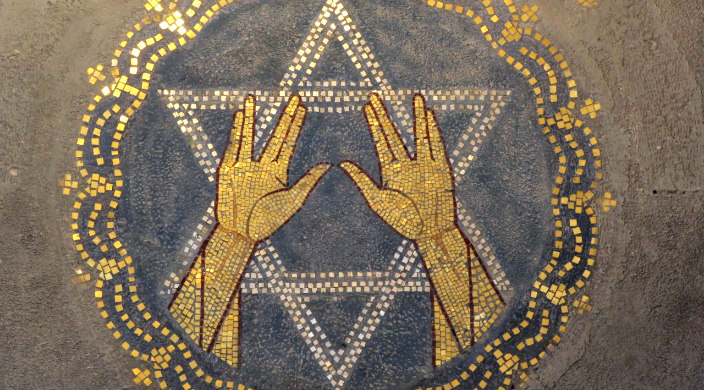
You’re probably familiar with the Star Trek hand symbol that means, “Live long and prosper!” Did you may know that Leonard Nimoy, who played Spock, was Jewish? He once said in an interview that he was inspired to create the Vulcan salute because he had seen the hand motion in synagogue as a child during the Priestly Benediction.
Parashat Naso (the Torah portion we read before opening week of the Jewish summer camp where I serve as director of Jewish life) contains the words of the Priestly Benediction, the prayer the priests (the descendants of Aaron during the Temple period) use to bless the Israelites. It’s also the prayer that modern-day rabbis use to bless their communities, acting as a medium through which God reaches the people.
As the Torah says in Numbers 6:23-27:
“Speak to Aaron and his sons: Thus shall you bless the people of Israel. Say to them: ‘May God bless you and guard you: May the light of God shine upon you, and may God be gracious to you: May the presence of God be with you and give you peace.’ Thus they shall link My name with the people of Israel, and I will bless them.”
And according to the Talmud, in tractate Sota 39a, we see that the priests are supposed to say yet another blessing in preparation for the Priestly Benediction in order to sanctify it: “Blessed are You, Sovereign of the universe, who sanctified us with the holiness of Aaron and commanded us to bless God’s people with love.” ( Sotah 39a).
As Rabbi Dr. Jenny Solomon asks in her d’var Torah “What’s Love Got to Do with It?" this leads us to ask the question “Why love?” Why is it so important that the priests acting as God’s messenger bless the Israelites with love ?
It seems that the Talmud is saying that the blessing over the people of the children of Israel must be sanctified – and that one way of doing that is through love.
This is something we also do with our campers. On Friday nights, we literally bless them during Shabbat dinner, and even when it’s not Shabbat , we use our love of community and Judaism to pass on a legacy to our children.
Our leadership and staff know, too, that our words and behaviors will trickle down to our staff and our campers. In fact, in many ways, it’s a trickle-down effect of our leadership’s love and care that translates into the love and care put in by our counselors that evolves into campers’ overall love of learning, community, and camp.
It is my hope, then, that even on our most difficult days, we can remember to sanctify with love everything that we pass on to our young Jewish campers – and in doing so, perhaps we can encourage them to “live long and prosper” while fulfilling the goals of the Priestly Benediction that we find in the Torah.
This d’var Torah was presented before the staff and leadership of URJ 6 Points Sci-Tech Academy – East , a Reform Jewish summer camp in Byfield, MA, during the first Shabbat of the camp’s 2019 summer season. Learn more about Reform Jewish summer camping and find a camp near you .
About the Author
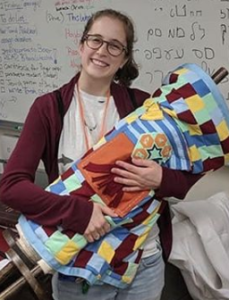
Julia Berg is the director of Jewish life at URJ 6 Points Sci-Tech Academy – East , a Reform Jewish summer camp in Byfield, MA. She is a rabbinical student at Hebrew Union College-Jewish Institute of Religion in Los Angeles, CA.
Related Posts
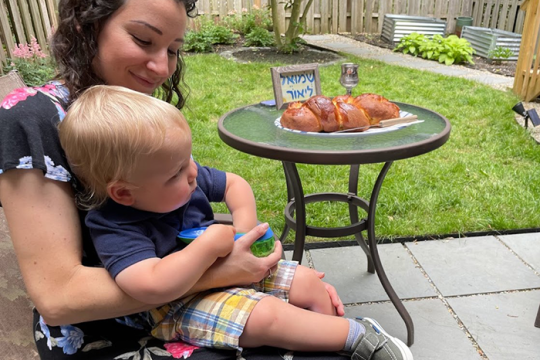
Melding Tradition and Innovation: Our Interfaith Toddler Naming Ceremony

Nine Spring-Inspired Hebrew Names
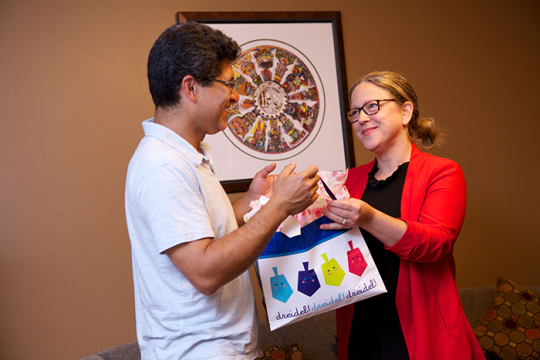
Your Hanukkah Gift-Giving Guide is Here!
Vulcan salute
- 1.1 Etymology
- 1.2 Pronunciation
- 1.3.1 Translations
- 1.3.2 See also
- 1.4 Further reading
English [ edit ]
Etymology [ edit ].
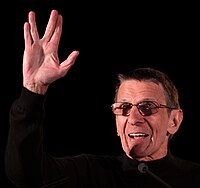
From Vulcan ( “ ( attributively ) inhabitant of the fictional planet Vulcan in the television series Star Trek ” ) + salute . The gesture was devised by the American actor Leonard Nimoy (1931–2015) who portrayed the half-Vulcan character Spock in the television series Star Trek (originally broadcast 1966–1969); he first used it in “ Amok Time ”, the first episode of the second season aired on September 15, 1967.
Pronunciation [ edit ]
- ( Received Pronunciation ) IPA ( key ) : /ˌvʌlkən səˈl(j)uːt/
- ( General American ) IPA ( key ) : /ˌvʌlkən səˈlut/
- Rhymes: -uːt
- Hyphenation: Vul‧can sa‧lute
Noun [ edit ]
Vulcan salute ( plural Vulcan salutes )
- [ 1984 November, Jean Lorrah , chapter 3, in The Vulcan Academy Murders ( Star Trek ; 20 ), New York, N.Y.: Pocket Books , →ISBN , page 22 : Sarek turned to the others, now offering the Vulcan salute . "Captain Kirk , Dr. McCoy , may you live long and prosper." / "Thank you, and the same to you, Mr. Ambassador," said Kirk, managing to force his hand into the proper position. ]
- 1986 December 22, Charles Leerhsen, “ Star Trek ’s Nine Lives”, in Newsweek , New York, N.Y.: Newsweek, Inc., →ISSN , →OCLC , page 66 ; quoted in Henry Jenkins III, “Star Trek Rerun, Reread, Rewritten: Fan Writing as Textual Poaching”, in Constance Penley, Elisabeth Lyon, Lynn Spigel , Janet Bergstrom, editors, Close Encounters: Film, Feminism, and Science Fiction (A Camera Obscura Book), Minneapolis, Minn.: University of Minnesota Press , 1991 (1993 printing) , →ISBN , page 171 : Hang on: You are being beamed to one of those Star Trek conventions, where grownups greet each other with the Vulcan salute and offer in reverent tones to pay $100 for the autobiography of Leonard Nimoy .
- 1995 March–April, Bill Grout, “Trial Run”, in Rick Kahl, editor, Skiing , volume 47 , number 7, New York, N.Y.: Times Mirror Magazines , →ISSN , →OCLC , page 24 , column 2: [W]e found a stalwart model [of glove]: Kombi's Lobster , a high-tech marvel with a unique clawlike design. [ … ] The split-finger design combines the warmth of a mitten with added dexterity, making it easier for riders to grip their boards. As a bonus, it also lets them give other riders the split-finger Vulcan salute , just like Mr. Spock on the original Star Trek .
- 1995 October, Leonard Nimoy , “Vulcanalia or The Vulcan Grows Up”, in I am Spock , New York, N.Y.: Hyperion , →ISBN , pages 67–68 : For what would soon become known as the Vulcan salute , I borrowed a hand signal from Orthodox Judaism. During the High Holiday services, the Kohanim (who are the priests) bless those in attendance. As they do, they extend the palms of both hands over the congregation, with thumbs outstretched and the middle and ring fingers parted so that each hand forms two vees. This gesture symbolizes the Hebrew letter shin , the first letter in the word Shaddai ; in the Jewish Qabala , shin also represents eternal Spirit.
- 2005 , Henry Bial, “Fiddling on the Roof, 1964–1971”, in Acting Jewish: Negotiating Ethnicity on the American Stage & Screen , Ann Arbor, Mich.: University of Michigan Press , →ISBN , page 69 : They may exchange Vulcan salutes in greeting as a sign of in-group status—the in-group being Star Trek fans rather than Vulcans.
- 2017 , Nicholas H. Kovacs, She Wants to Dance with Me: A Script for a Theatrical Play , [Morrisville, N.C]: [ Lulu.com ], →ISBN , scene vi, page 35 : Ooh! The Vulcan Salute ! It is easy! [She demonstrates the Vulcan Salute again.] Peace and long life. Y'all supposed to respond back to me with; " Live long and prosper. "
- 2019 , Sherilyn Connelly, “Prologue: Star Trek—The MacArthur Premiere”, in The First Star Trek Movie: Bringing the Franchise to the Big Screen, 1969–1980 , Jefferson, N.C.: McFarland & Company , →ISBN , page 20 : [B]oth he [ George Takei ] and [Grace Lee] Whitney [ … ] waved and offered Vulcan salutes to the fans assembled to the south, while also doing their due diligence for the professional photographers to the north.
Translations [ edit ]
See also [ edit ].
- Unicode: 🖖 ( U+1F596, 🖖 )
Further reading [ edit ]
- English terms derived from Proto-Indo-European
- English terms derived from the Proto-Indo-European root *solh₂-
- English endocentric compounds
- English compound terms
- English terms with IPA pronunciation
- Rhymes:English/uːt
- Rhymes:English/uːt/4 syllables
- English lemmas
- English nouns
- English countable nouns
- English multiword terms
- English terms with quotations
- English adjective-noun compound nouns
- en:Star Trek
- Word of the day archive
- English terms with non-redundant non-automated sortkeys
- English entries with topic categories using raw markup
- English entries with language name categories using raw markup
Navigation menu
- Newsletters
- Account Activating this button will toggle the display of additional content Account Sign out
Listen to Leonard Nimoy Explain the Jewish Origins of His Famous Vulcan Hand Greeting
Leonard Nimoy, who passed away Friday, sat down with the Wexler Oral History Project last year, his impressive Yiddish skills on full display . In the video below, Nimoy describes the origin of his famous Star Trek hand greeting: The Jewish priestly blessing, or duchening . He’d already revealed this in his 1975 autobiography I Am Not Spock , but the video is still delightful.
As a curious young boy at synagogue, Nimoy recalled peeking from under his father’s talit as the priests blessed the congregation. He described what he saw as “magical.” Years later, while filming an episode of Star Trek , the first with other Vulcans, he suggested a special greeting—and it stuck. “It’s great,” he said, “people don’t realize they’re blessing each other.”

7 Famous Hand Signs Used in Movies
Table of Contents
7 famous hand signs used in movies, vulcan hand salute from star trek, the atreides blade salute from dune, the “these aren’t the droids you’re looking for” jedi mind trick gesture from star wars, the hail skroob salute from spaceballs, the 3-finger “district 12” sign from hunger games, the zoltan sign from dude, where’s my car, wrapping up.

Like any good art, much of cinema is full of bizarre and unique fictional inventions, from whole languages and worlds to small but fascinating details such as salutes and hand signs. In sci-fi and fantasy, in particular, additions such as these can make all the difference when it comes to creating the right atmosphere and an overall believable and memorable fictional world. So, let’s go over some of the most famous hand signs used in movies and what they mean.
Going over all the popular hand signs and gestures from movies would be a lost cause, especially considering how far back movie history goes. This is even more so if we consider foreign cinema. There are some signs that stand the test of time, however, and are easily recognizable even decades after they first hit the big screen.
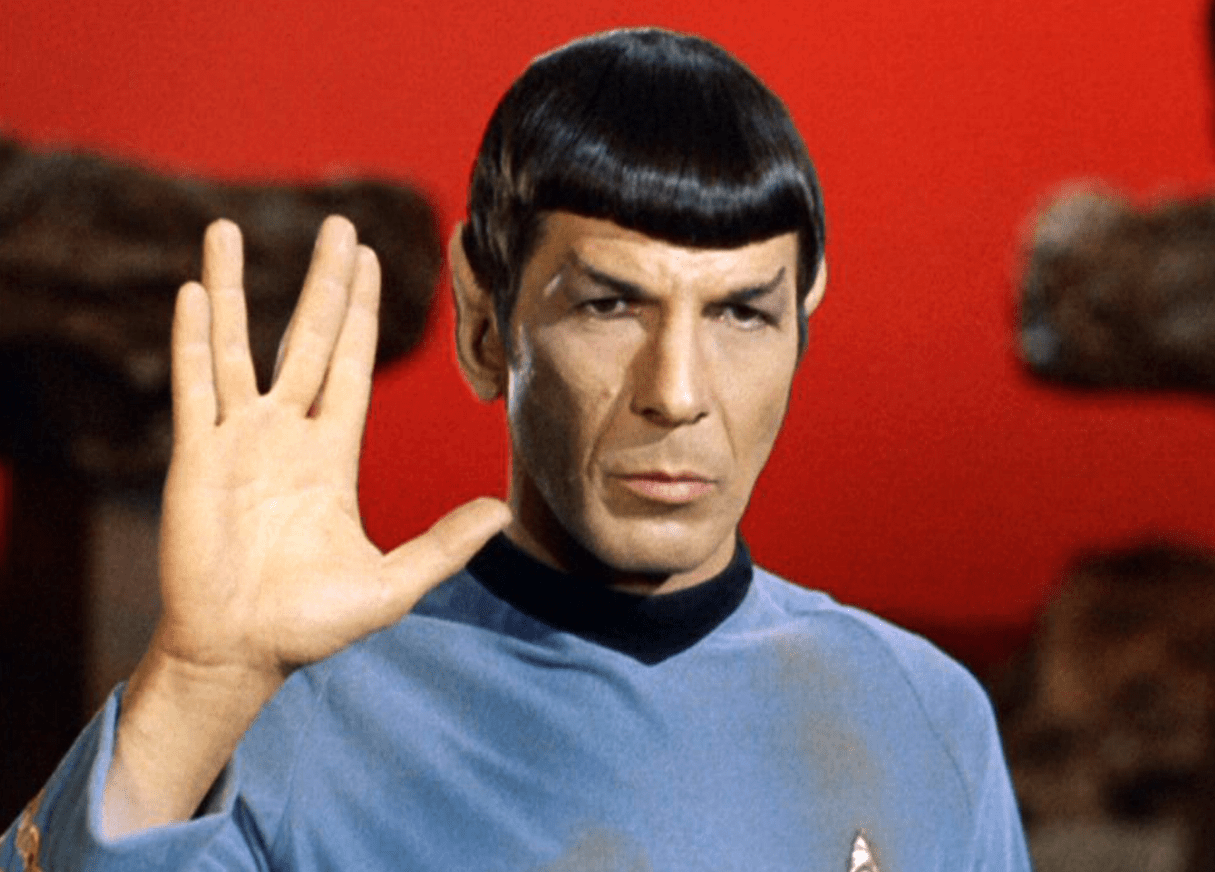
There is hardly a more recognizable fictional hand gesture in all of movie history and sci-fi in general than the Vulcan salute from Star Trek . Usually accompanied by the iconic phrase “Live long and prosper”, the salute does have a very clear-cut and simple meaning behind it – it’s a greeting and/or farewell sign, wishing the other person to live long and prosper.

The exact in-universe origin or any deeper meaning of the salute isn’t known but we do know that actor Lenard Nimoy came up with it in real life . According to him, the Vulcan salute came up as a combination of a Jewish hand salute he had seen as a child and Winston Churchill’s peace sign .
The 2021 Denis Villeneuve adaptation of Frank Herbert’s Dune came with a lot of surprises. Many people were astonished at how well and closely the movie managed to follow the first book of the series while others were shocked by some of the changes made by the adaptation.
One of the curious examples is the famous hand and blade salute of House Atreides. In the books, it’s described as members of House Atreides touching their foreheads with their blades. Most readers seem to have imagined this as something similar to the classic fencing salute.
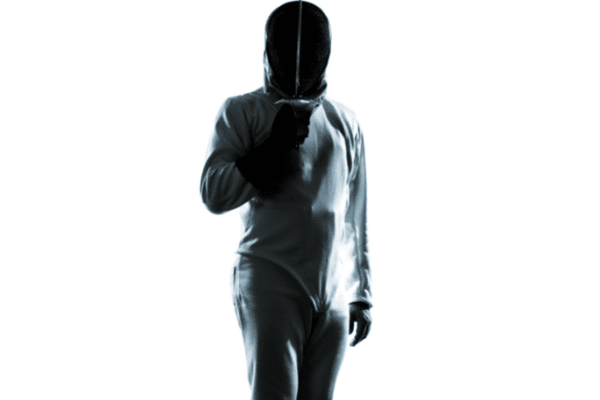
Yet, in the movie, the salute is shown a bit differently – with the characters first putting their blade-holding fist in front of their hearts and then lifting it above their heads, lifting the blade horizontally above the forehead.
Is this really a major change or is this what Herbert actually envisioned? Even if it isn’t, there’s no doubt that the movie’s version also looks epic and fits very well with the tone and atmosphere of Dune’s world.
Not really a sign, a greeting, or a salute, this is rather just a gesture used by the Jedi Force users in the Star Wars franchise. Used to slightly manipulate the target’s memories and behavior, this gesture was first used by Obi-Wan Kenobi’s original actor Alec Guinness in 1977’s Star Wars .
Since then, the Jedi mind trick was used in various other installments of the Star Wars franchise such as The Phantom Menace in 1999 when Qui-Gon Jinn played by Liam Neeson tried and failed to mind trick the Toydarian Watto. More than that, the hand sign has also been widely used by fans of the franchise as both a greeting and a meme.
For a salute full of some irreverent humor, there are few betters places to go to than Spaceballs . This masterful satire of Star Wars and other popular flicks managed to craft the perfect two-part salute for its genre – first, the universal F-you sign and then a dainty finger wave. Do we need to look for some extra meaning in this classic Mel Brooks joke? Certainly not.
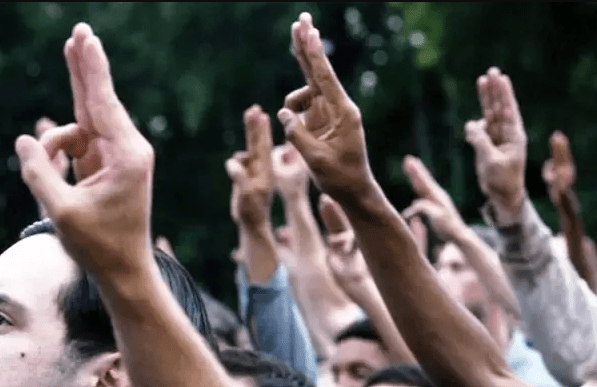
The famous hand salute from the Hunger Games franchise is easily recognizable but it’s not actually original. Anyone who’s ever been in the scouts knows that this sign comes from there, not from the Hunger Games books or movies.
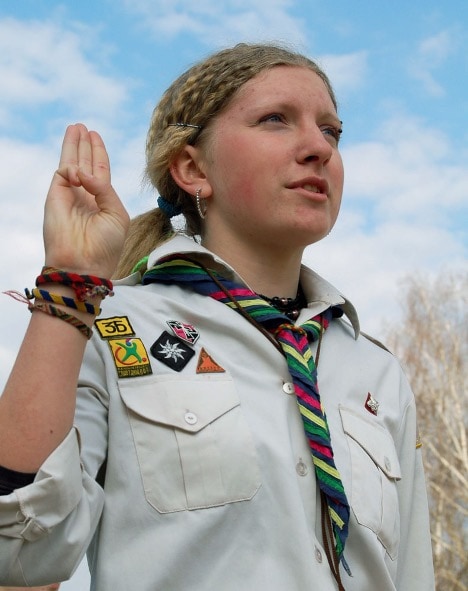
The sign in the young adult franchise does come with a bit of flair, however. First, it starts with a kiss on those same three fingers before they are raised in the air. Secondly, the sign is also often accompanied by the famous Hunger Games whistle.
What’s more, the sign is also full of in-universe symbolism. In the story, it starts off as a funeral gesture but it quickly evolves into a symbol of District 12 as well as of the broader revolution, while the protagonist Katniss Everdeen starts using it in the Hunger Games tournament. Fans of the series also use the sign in real life to this day to signify their part in the fandom.
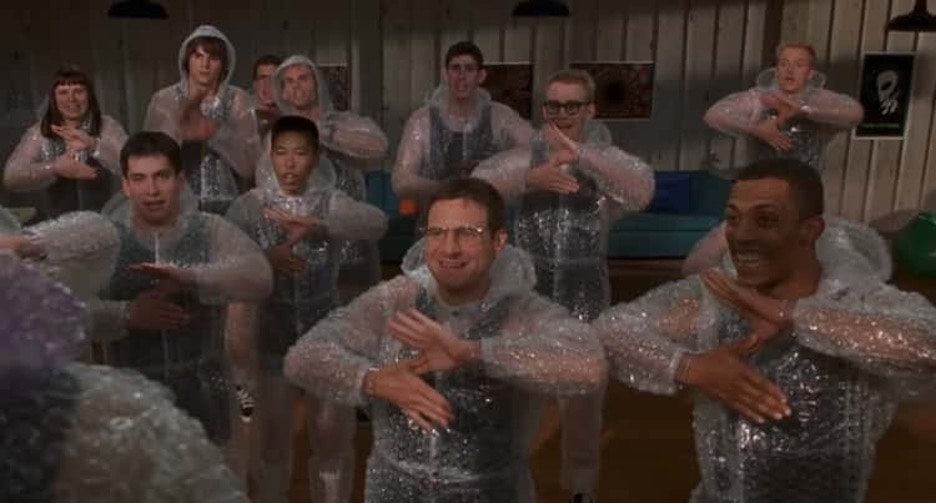
Onto another classic satire, the 2000 Ashton Kutcher and Sean William Scott comedy Dude, Where’s My Car? had one of the simplest and most iconic hand signs in movie history – the Zoltan sign.
A simple Z formed by touching the thumbs of both hands and spreading the fingers in different directions, this symbol didn’t really have a deeper meaning in the movie, other than poking fun at the cult leader of a ridiculous group of UFO worshippers.
Curiously enough, however, the symbol was later adopted by a US baseball team. The Pittsburgh Pirates jokingly used the sign after one successful game 12 years after the movie had come out. The players appear to have done it as a joke but the fans caught on immediately and turned the Zoltan sign into a new symbol for the team going forward.
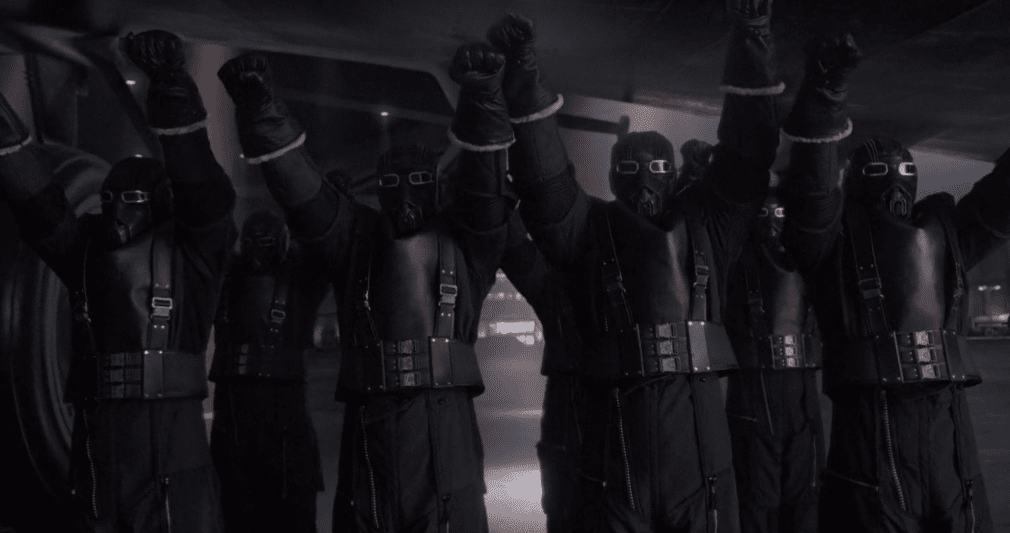
Let’s end things on a famous fictional salute that maybe tried to be serious but still looks kind of funny regardless. Coming straight from Marvel Comics and into the MCU in 2011, the Hail Hydra salute is a play on the famous Hail Hitler salute of Nazi Germany.
Only in this case, it’s both arms instead of just one and with closed fists instead of a flat hand. Does it make a bit of sense? Sure. Does it have any deeper meaning? Not really.
All in all, these are just a few of the many famous hand signs used in movies and popular culture. If we are to extend a wider look into TV shows, animation, and video game franchises we’d find dozens and hundreds more, each more unique than the next. Some have deeper meanings, others are straightforward but still iconic, and quite a few are just jokes and memes. Yet, they are all quite memorable and fascinating nevertheless.
Yordan Zhelyazkov is a published fantasy author and an experienced copywriter. While he has degrees in both Creative Writing and Marketing, much of his research and work are focused on history and mythology. He’s been working in the field for years and has amassed a great deal of knowledge on Norse, Greek, Egyptian, Mesoamerican, Japanese mythology, and others.
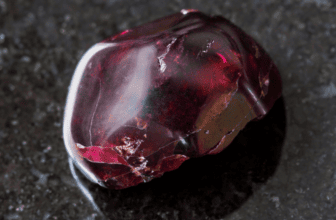
- The Philosopher’s Stone: Myth, Magic, and Immortality
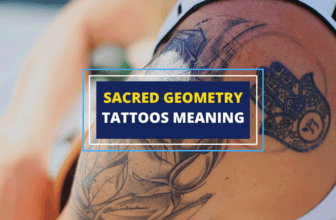
8 Powerful Sacred Geometry Symbols for Tattoos & Why
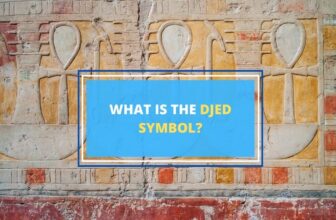
Djed Symbolism: Was It the Backbone of Osiris?
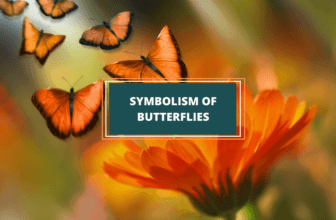
Powerful Symbolism of Butterflies from Around the World

Find Us On Social Media
Quick links.
- Privacy Policy
- Terms of Use
Latest Posts
- Metatron: How Is He the Most Powerful Angel of Them All?
- Every Major Pagan Path Explained
- What Were the Eleusinian Mysteries Really About?
© Copyright Symbol Sage, 2024. All Rights Reserved.
The Iconic “Live Long and Prosper” Hand Gesture Was Originally a Jewish Sign
The hand gesture itself is a slight modification of the Hebrew gesture forming the letter “Shin”, which represents the name “Shaddai” meaning “Almighty” (God). This gesture is still used today by orthodox Jews of the Kohanim, which are priests descended from Ahron by the patrilineal line. These Kohanim form a subset of the descendants of the priestly Levite tribe.
The Kohanim use the Shin gesture during a blessing ceremony, the nesiat kapayim or the “Priestly Blessing”, that accompanies the prayer service. The actual Jewish blessing is done with both hands, not just one, extended outward. In this gesture, the arms are then held at a roughly 45 degree angle, level with the shoulders, as opposed to the completely vertical salute fashion in the “live long in prosper” version of the gesture.
The hand gesture itself wasn’t the only part that was borrowed from Jewish tradition. The “live long and prosper” and the lesser known Vulcan traditional response of “peace and long life” was based on the Jewish “Shalom Aleichem” (peace be upon you) and the traditional reply of “Aleichem Shalom” (upon you be peace).
If you liked this article, you might also enjoy our new popular podcast, The BrainFood Show ( iTunes , Spotify , Google Play Music , Feed ), as well as:
- The Actor Who Played “Scotty” on Star Trek was Shot 6 Times on D-Day
- “To Boldly Go Where No One Has Gone Before” is Thought to Have Been Borrowed from a White House Pamphlet on Space
- The Man Who Tried to Raise His Son as a Native Speaker of Klingon
- Split Infinitives, like “to boldly go”, are Not Incorrect Grammatically
- “Beam Me Up Scotty” was Never Said in the Original Star Trek and Other Interesting Star Trek Facts
Bonus Facts:
- The Hebrew Priestly Blessing itself can be found in the Bible in Numbers 6:22: “May the Lord bless you and keep you. May the Lord make his face to shine upon you and be gracious to you. May the Lord lift up his countenance upon you and give you peace.”
- Nimoy also was the one to come up with the Vulcan nerve pinch. In the first episode this pinch showed up, Spock was originally supposed to club evil Kirk over the head, knocking him out. Nimoy thought this was inconsistent with Spock’s personality. He felt a non-violent nerve pinch would be more fitting with Vulcan’s being able to emit energy from their fingertips; this energy when applied to the correct nerves of a human would then render the human unconscious.
- Jewish worshipers are not supposed to look at the Kohanim while the blessing is being given as this would distract them from the words of the blessing itself. As a child, Nimoy couldn’t contain himself however and snuck a peak. As he said, “The special moment when the Kohanim blessed the assembly moved me deeply, for it possessed a great sense of magic and theatricality… I had heard that this indwelling Spirit of God was too powerful, too beautiful, too awesome for any mortal to look upon and survive, and so I obediently covered my face with my hands. But of course, I had to peek.” (From his autobiography, I am Spock .)
- In Act 5 Scene 3 line 42 of Shakespeare’s Romeo and Juliet, Romeo says to Balthasar, “Live and be prosperous, and farewell good fellow.”
- The actress who played T’Pau, Celia Lovsky, couldn’t do the salute, which was a problem in the filming of “Amok Time”. In order to get around this issue, they simply filmed with her hands starting below the camera frame; she’d then use her other hand to get the one hand into the proper position, which she could then hold for a couple seconds before losing it.
- Ancient Egyptians had a common phrase that is properly translated today to, “May he live long, prosper, and be in health.”
- After Star Trek was canceled, Nimoy immediately joined the cast of Mission Impossible as an IMF agent. He played this role in the fourth and fifth seasons of the show.
- Nimoy officially retired in April of 2010, his reasons being his age and his hope that by bowing out, Zachary Quinto would be able to better enjoy the full media attention of being Spock.
- Leonard Nimoy
- The Jewish Origin of the Vulcan Salute
- Vulcan Salute
- Entertainment
24 comments
Hey nice article. I’m Jewish and it’s definitely not just Orthodox Jews that use this gesture. Indeed I have seen it used by Reform and Conservative rabbis or Kohanim. So it is universal. Another fact is that if you go to a Jewish cemetery, you will see this and symbol on the grave stones of anyone with the last ne Cohen, Katz, Getz, Kahn, etc.
[…] Original post: The Iconic “Live Long and Prosper” Hand Gesture Was Originally a Jewish Sign […]
[…] This post was mentioned on Twitter by Matthias Rascher. Matthias Rascher said: @TheRealNimoy The Iconic “Live Long and Prosper” Hand Gesture Was Originally a Jewish Sign. http://bit.ly/aISSpF Aha. […]
Interesting! I didn’t know Spock was a jew at his roots!
This is no secret, Nemoy has been explaining this for many years. Both Nemoy and Shatner are Jews, Nemoy is pretty religious. “Goy” does not mean “cattle.” It translates as “nations,” as “Lo yisa goy…”, “The NATIONS will study war no more.”
Goyim is Yiddish slang for “cattle”.
this is interesting, muslims say “as-salam alaikum – alaikum salam” which means exactly the same thing…
Wear do you think they got it from??
I knew nimoy was Jewish but not Shanter
As a person with cerebral palsy, I CANNOT do this hand gesture, no matter how hard I try. What say you to that, God of the Jews? Or was just this “man’s” attempt to have a hand symbol of the Almighty?
Ask a Rabbi – if you needed to do it for the prayer, they’d come up with something. The symbol a Shin (looks like a W in English) is commonly used in Judaism to refer to the name of G’d. Judaism is nothing if not complex. There’s always a way to talk any problem to death. Figuring out how to properly accommodate you so you weren’t shamed in any way or left out, would be a proper problem for a Rabbi to solve.
From wiki: According to the Torah,[3] Aaron blessed the people after offering sacrifices,[4] and YHWH[5] promises that “I will place my name on their hands” (the Kohanim’s hands) “and bless them” (the Jews receiving the blessing). [6]
So whether you think it’s from G’d or from man, depends on whether you think Torah is written by G’d or written by man who were inspired or is a collection of stories.
Leopold Bloom (Milo O’Shea) (from Ulysses – by Joseph Strick, aired June 1967 in UK) did this hand gesture at 1h07min08sec.
He’s also referencing Bnai Brith and it sounds like babbling…
Sometimes it’s time for an idea to appear and then it does, in multiple places. Like evolution was identified by two different scientists. Darwin had more status and connections.
- More to Explore
- Series & Movies
Published Mar 26, 2021
Nimoy Family and Boston's Museum of Science Announce Vulcan Salute Monument
The sculpture will honor beloved entertainer's life and legacy as a symbol of peace and unity
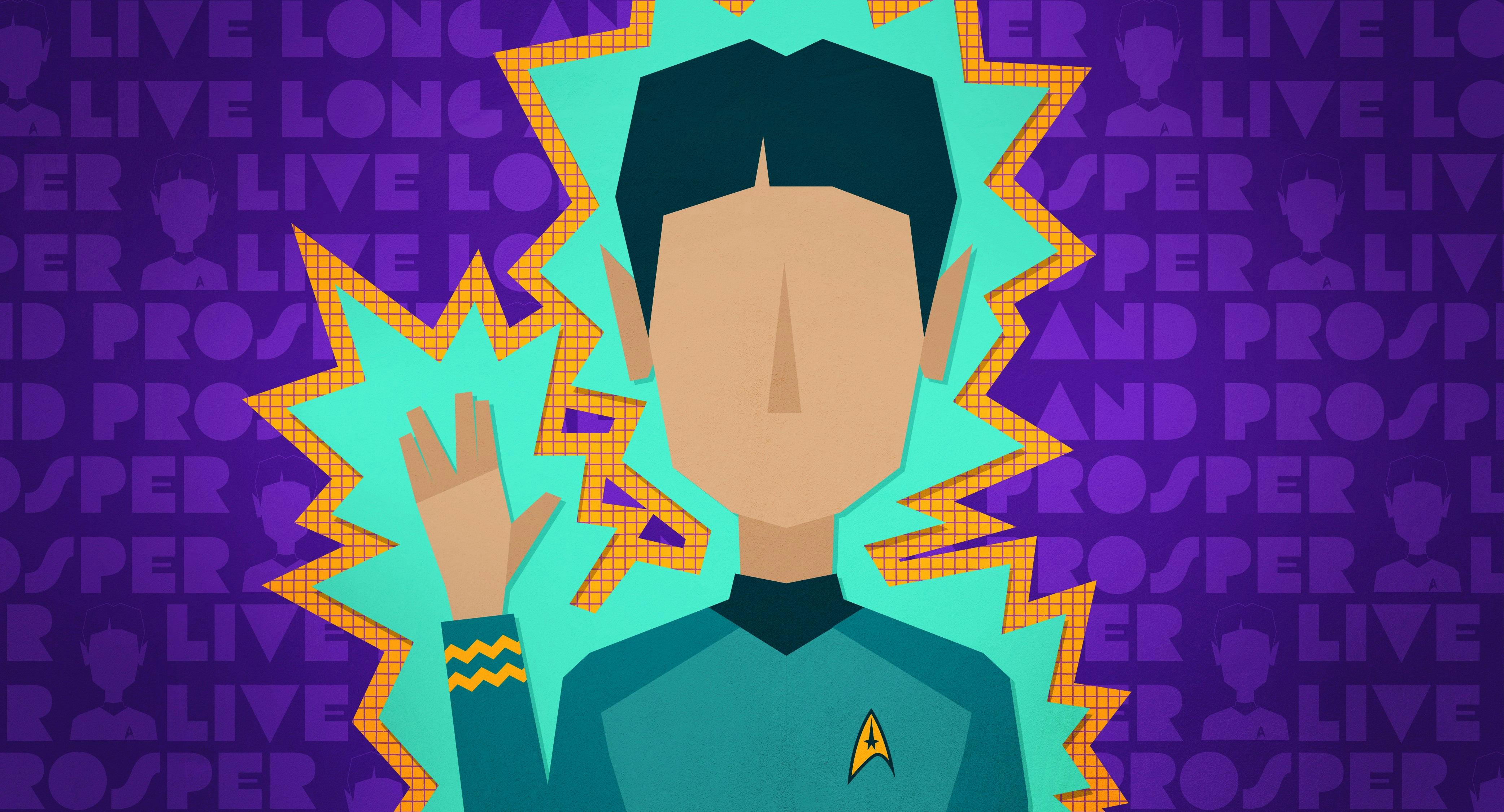
StarTrek.com
The Museum of Science, Boston, one of the world’s largest science centers and one of Boston’s most popular attractions, in collaboration with the family of Leonard Nimoy, legendary actor of the historic television series, Star Trek , today, announced the development of a monument honoring the Boston native to be located at the Museum of Science.
The 20-foot, illuminated, stainless steel monument, designed by artist David Phillps, will be shaped in the famous “Live Long and Prosper” hand gesture that the actor’s character Mister Spock was known for. It will be located in front of the Museum, at Science Park, welcoming visitors and Star Trek fans from around the world.
“The “Live Long and Prosper” symbol represents a message that my dad believed so strongly in,” said Julie Nimoy, daughter of the entertainer. “My dad always loved Boston and he would be honored knowing that the Museum of Science would be the permanent home to this memorial. The sculpture not only depicts one of the world’s most recognized and loved gestures for peace, tolerance, and diversity, but it will also be a beautiful tribute to my dad’s life and legacy.”
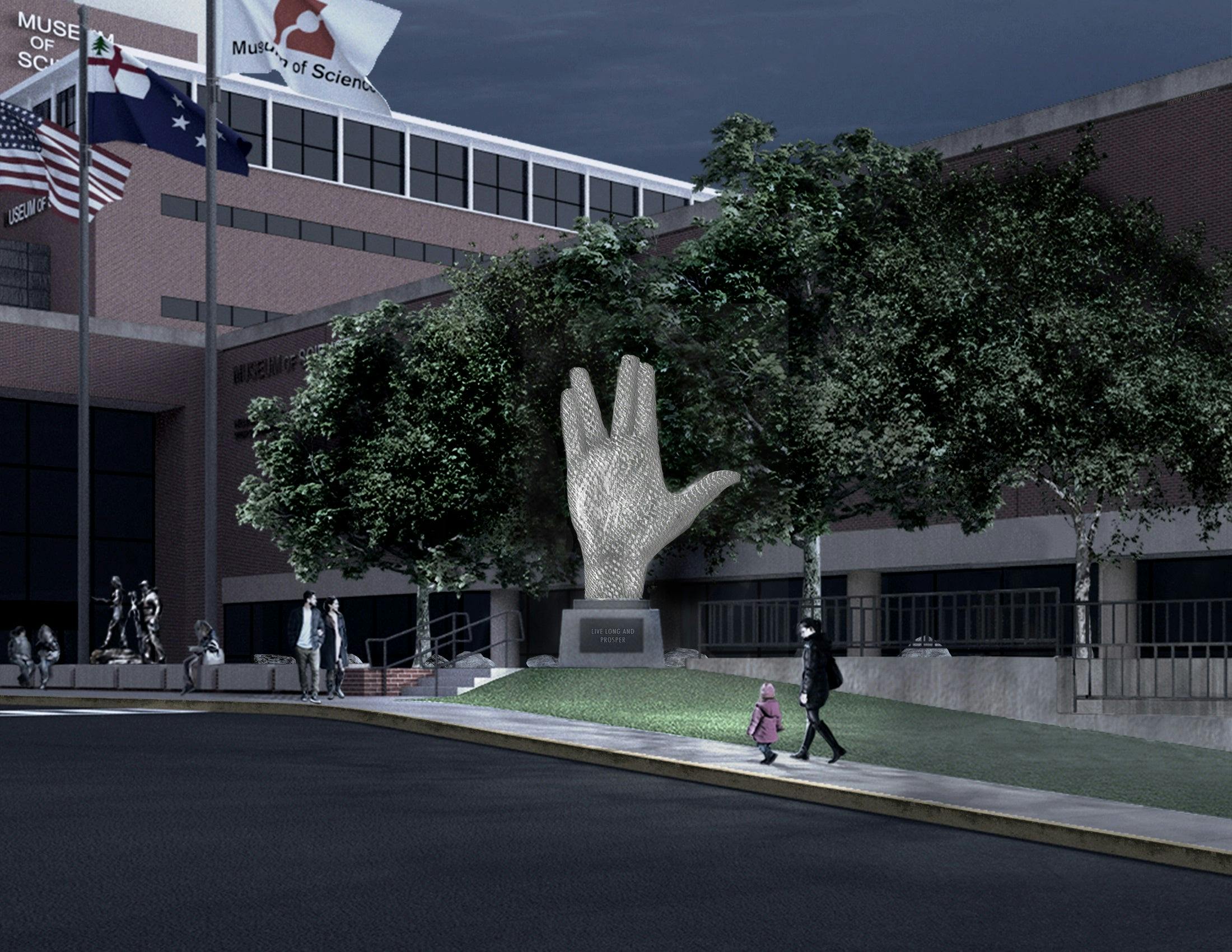
Leonard Nimoy’s career spanned over 60 years as an award-winning actor, director, producer, writer, recording artist and photographer. He is one of Hollywood's most recognized and loved entertainers. Born in the West End of Boston, just blocks from where the Museum of Science is now located, Nimoy’s values for unity and tolerance, stemmed from his early days growing up in Boston.
The idea for the Live Long and Prosper hand gesture as the Vulcan greeting, originated from Nimoy himself, who was inspired by an ancient blessing he saw growing up in his synagogue. Later, in the 1980’s Nimoy collaborated with the Museum of Science as the recognizable voice of the original introduction film of the Mugar Omni Theater which has welcomed millions of audience members over the past three decades.
“Leonard Nimoy was one of our own. Growing up a few blocks from the Museum of Science, he never forgot his immigrant roots. He was, and forever will be, a beloved part of our Museum family,” says Tim Ritchie president of the Museum of Science. “He lifted our aspirations and hopes through his commitment to science, intellectual curiosity, generosity, and, yes, logic. He reminded us about the best part of humanity and gave us a vision for building a society based on reason and tolerance. The opportunity to pay tribute to him is a great honor and what better day to make this announcement than on what would have been his 90th birthday.”
The Museum of Science and the Family of Leonard Nimoy will collaborate on the next phases of development of the Leonard Nimoy memorial sculpture which will include finalizing site plan, fundraising, and construction. Those interested in donating to the memorial fund can visit the Museum of Science Boston's official site.
Get Updates By Email

IMAGES
VIDEO
COMMENTS
Vulcan salute. The Vulcan salute is a hand gesture popularized by the 1960s television series Star Trek. It consists of a raised hand with the palm forward and the thumb extended, while the fingers are parted between the middle and ring finger. The gesture was devised by Star Trek actor Leonard Nimoy as a salute for the alien Vulcan species ...
NBC. By Max Miller / Sept. 4, 2023 9:00 pm EST. There is no more iconic hand gesture in pop culture than the split-fingered greeting used by Spock (Leonard Nimoy) and other Vulcans in "Star Trek ...
The Star Trek hand symbol holds great significance and meaning, representing the iconic Vulcan salute and the values of unity, peace, and logic in the Star Trek universe. This article explores the origins and cultural impact of this symbol, diving into the depths of its meaning and how it has resonated with fans worldwide.
Sci-fi. Star Trek. The Vulcan salute was a hand gesture used by Vulcans. It involved holding the palm of one hand outwards while placing the fingers in a "V" shaped by separating the middle and ring fingers, while keeping the others together, with the thumb extended. The salute was part of both Vulcan greetings...
I f one visits the legendary Grauman's Chinese Theater in Hollywood, California (now called the TCL Chinese), one can see the handprints of the cast and creator of "Star Trek." On the event of the ...
In 2012, StarTrek.com caught up with Nimoy to ask about the history behind the gesture and how it came to life on set. Inspired by a gesture he'd seen during a blessing at an orthodox Jewish shul as a boy, Nimoy carried the memory with him until the fateful day filming the scenes on Vulcan in "Amok Time.". "The idea came when I saw the ...
Published February 27, 2015. Leonard Nimoy's passing at the age of 83 is prompting a flood of reminiscences about the actor, artist, and poet best known for his portrayal of the half-human/half ...
The Vulcan salute went memetic almost immediately after Nimoy's first usage of the gesture. According to Nimoy, mere weeks after "Amok Time" aired, people were already using the gesture to greet him everywhere he went. The gesture was first popular among Star Trek fans but the gesture's similarity to the popular V-shaped peace hand gesture ( ️), both in finger placement and good ...
The Vulcan salute in Star Trek has a profound meaning that connects to Leonard Nimoy's life. ... The hand sign invokes a letter of the Hebrew alphabet. Read Full Story.
Writer Lindsay Traves explored the history of the Vulcan salute for the Star Trek blog in 2019 in honor of Jewish History Month. Rabbi Howard Morrison of Toronto's Beth Emeth Synagogue explained that the gesture, made with both hands with thumbs connected, forms the Hebrew letter Shin, which is the first letter of Shaddai, one of the names for God in the Torah.
The most famous Jewish influence on Vulcan culture in Star Trek is the "live long and prosper" hand gesture. This "Vulcan salute," as it has come to be called, was invented on the set by Leonard ...
In the Star Trek universe, the delta emblem is a direct descendant of the vector component of the old NASA (and later UESPA) logos in use during Earth's space programs of the 20th and 21st Centuries.Those symbols were worn by some of the first space explorers and adorned uniforms and ships during humanity's first steps into the final frontier.
Vulcan finger-touching was a ritualistic gesture among Vulcans involving the index and middle fingers. It was used throughout their culture, including in public as a greeting or to signify affection, intimacy, respect, or meditation. It was also used at reunions, at wedding ceremonies, and during the pon farr. Contact ranged from a simple two-fingertip touch to tracing around another's hand ...
The Corna. 4. The Pledge of Allegiance. 5. The High Five. 1. The Vulcan Salute. We all know it, even if we can't all do it. The Vulcan Salute, made famous by Leonard Nimoy as Mr. Spock on the ...
Leonard Nimoy (Beth Madison photo) "Liv e long and prosper." These words, along with the Vulcan salute, are immediately recognized and associated with Star Trek, which is celebrating the 53rd anniversary of its first episode this month.Their origins do not emanate from the vast final frontier, however, but rather from Leonard Nimoy's Jewish heritage.
Star Trek Logos and Symbols, Artwork by Kris Trigwell » Star Trek Minutiae. The talented Kristian Trigwell (aka "Reverend") spent many months researching hundreds of logos, insignia, and symbols seen in every Star Trek series and movie, and then faithfully reproduced them as vector artwork. He also included a few original designs of his own.
You're probably familiar with the Star Trek hand symbol that means, "Live long and prosper!"Did you may know that Leonard Nimoy, who played Spock, was Jewish? He once said in an interview that he was inspired to create the Vulcan salute because he had seen the hand motion in synagogue as a child during the Priestly Benediction.
A gesture of greeting among Star Trek fans, consisting of a raised hand with the palm forward and the thumb extended, and the fingers parted between the middle finger and ring finger. [1984 November, Jean Lorrah, chapter 3, in The Vulcan Academy Murders (Star Trek; 20), New York, N.Y.: Pocket Books, →ISBN, page 22: Sarek turned to the others, now ...
Feb 27, 20152:16 PM. Leonard Nimoy, who passed away Friday, sat down with the Wexler Oral History Project last year, his impressive Yiddish skills on full display. In the video below, Nimoy ...
The 3-finger "District 12" sign from Hunger Games. The famous hand salute from the Hunger Games franchise is easily recognizable but it's not actually original. Anyone who's ever been in the scouts knows that this sign comes from there, not from the Hunger Games books or movies. Source: Viktor Gurniak, Yarko. CC BY-SA 3.0.
June 30, 2010 Daven Hiskey. Today I found out the iconic "live long and prosper" hand gesture was originally a Jewish sign. The hand gesture itself is a slight modification of the Hebrew gesture forming the letter "Shin", which represents the name "Shaddai" meaning "Almighty" (God). This gesture is still used today by orthodox ...
Vulcan salute I am a "Treckie", but not a "nerd", though I am kind of "geekie" and proud of it, I remember rushing home, through out the '70'"s. after school to watch Star Trek, just so I could hear the word's "live long and prosper," and try to figure out how he did it...I guess what I'm trying to say is may the memory of, and all of the joy and curiosity in science, music, and space, Leonard ...
The 20-foot, illuminated, stainless steel monument, designed by artist David Phillps, will be shaped in the famous "Live Long and Prosper" hand gesture that the actor's character Mister Spock was known for. It will be located in front of the Museum, at Science Park, welcoming visitors and Star Trek fans from around the world.